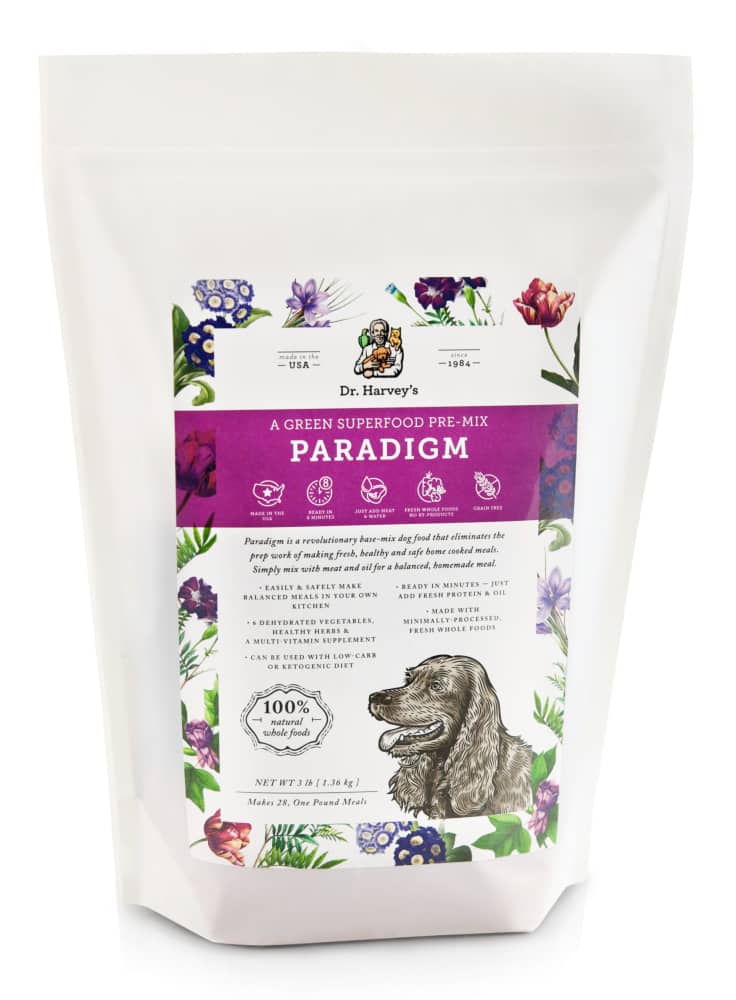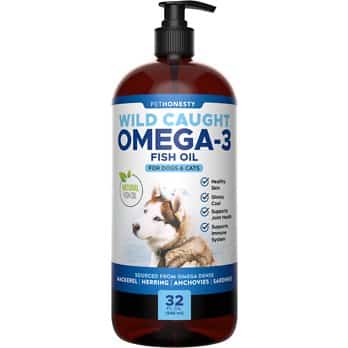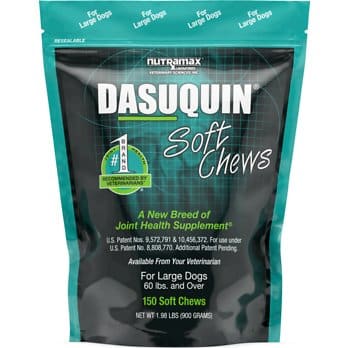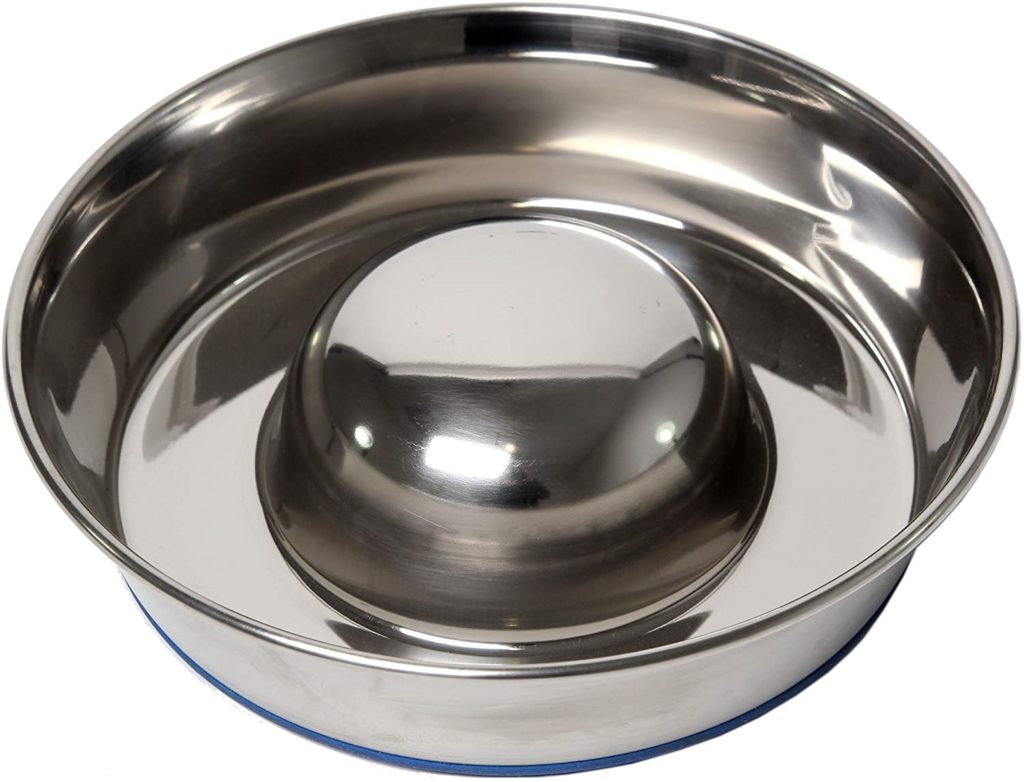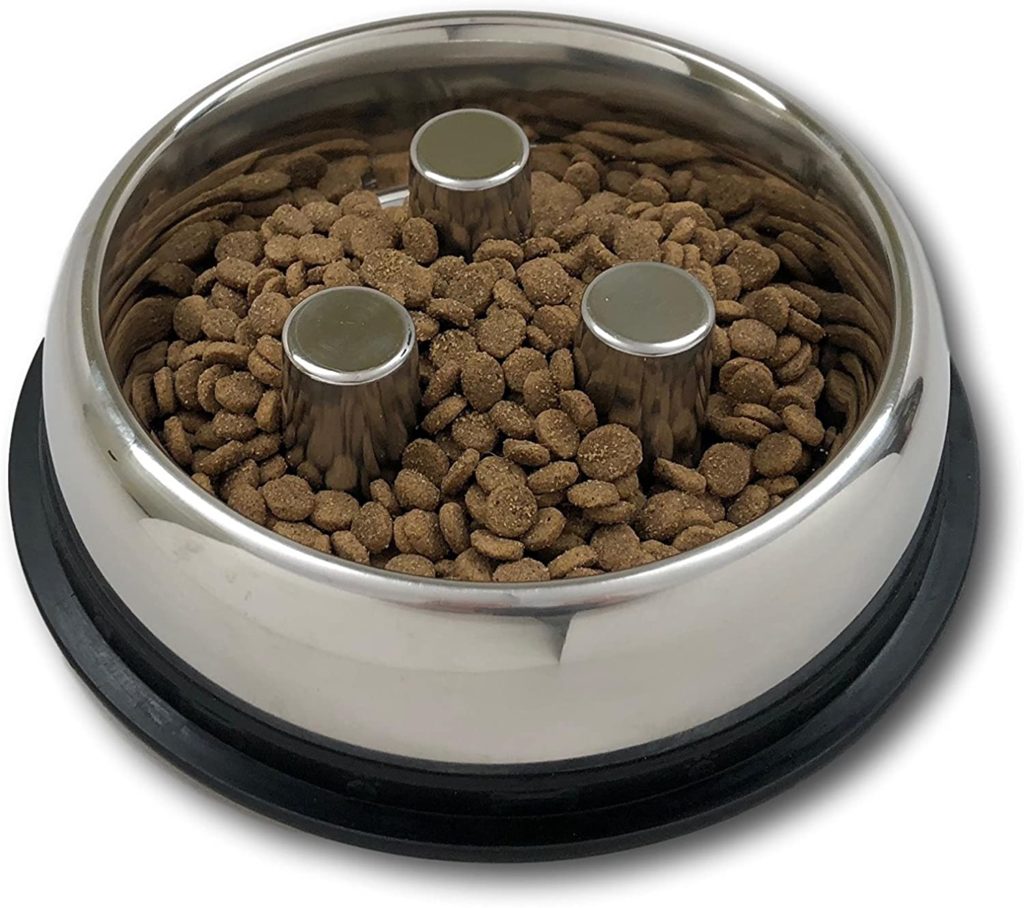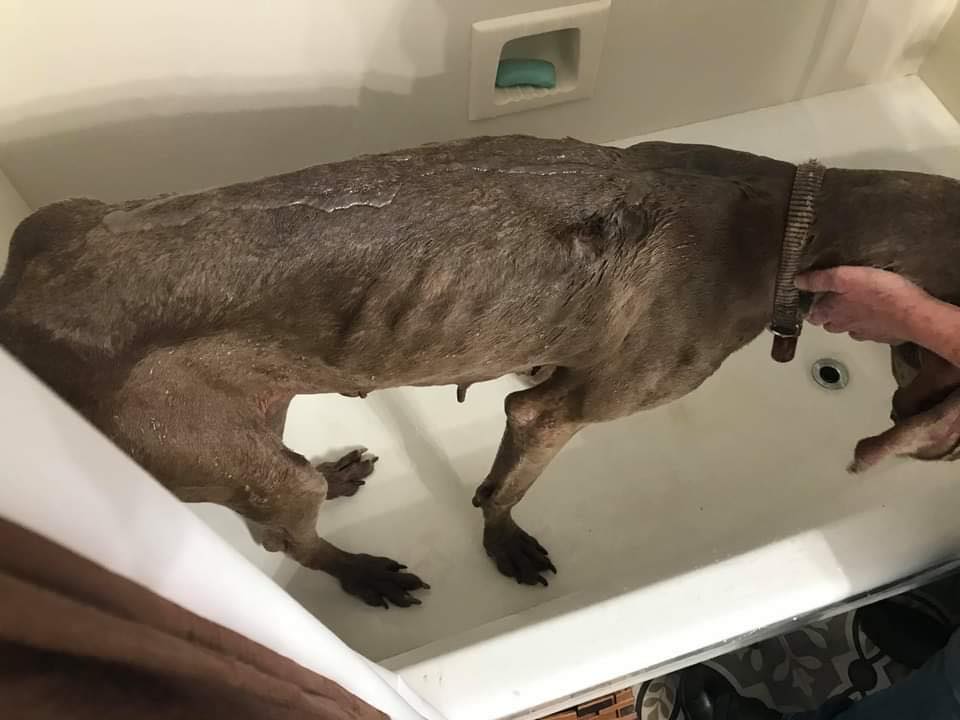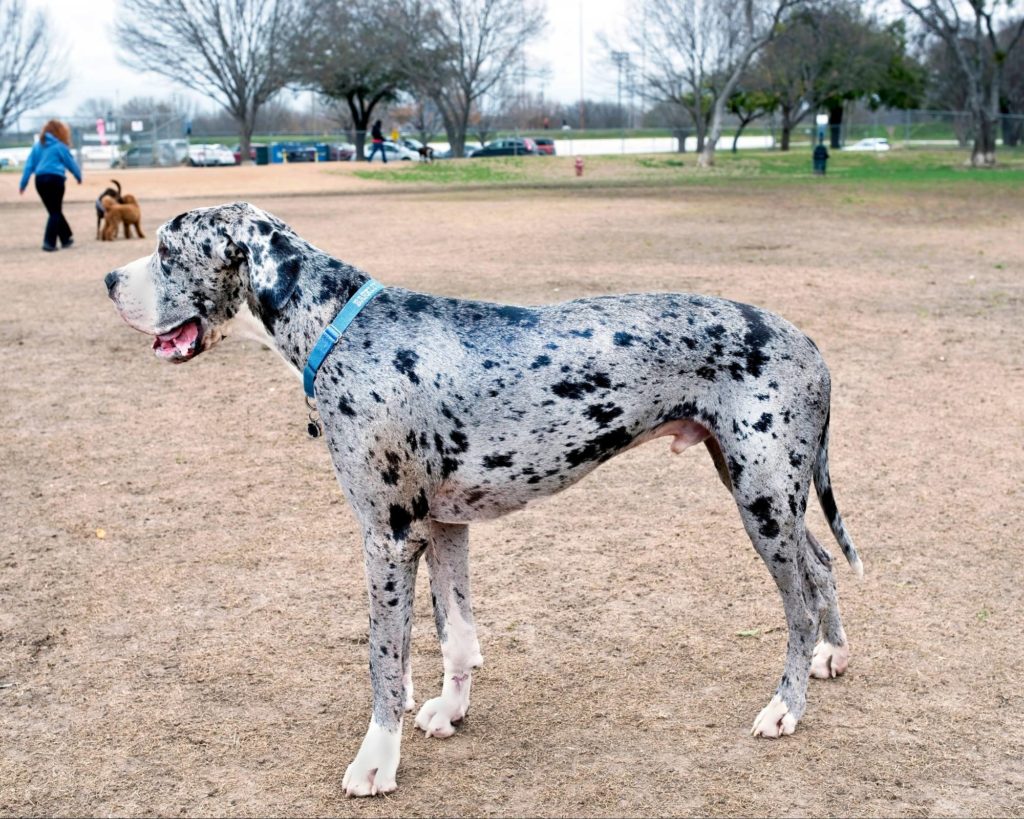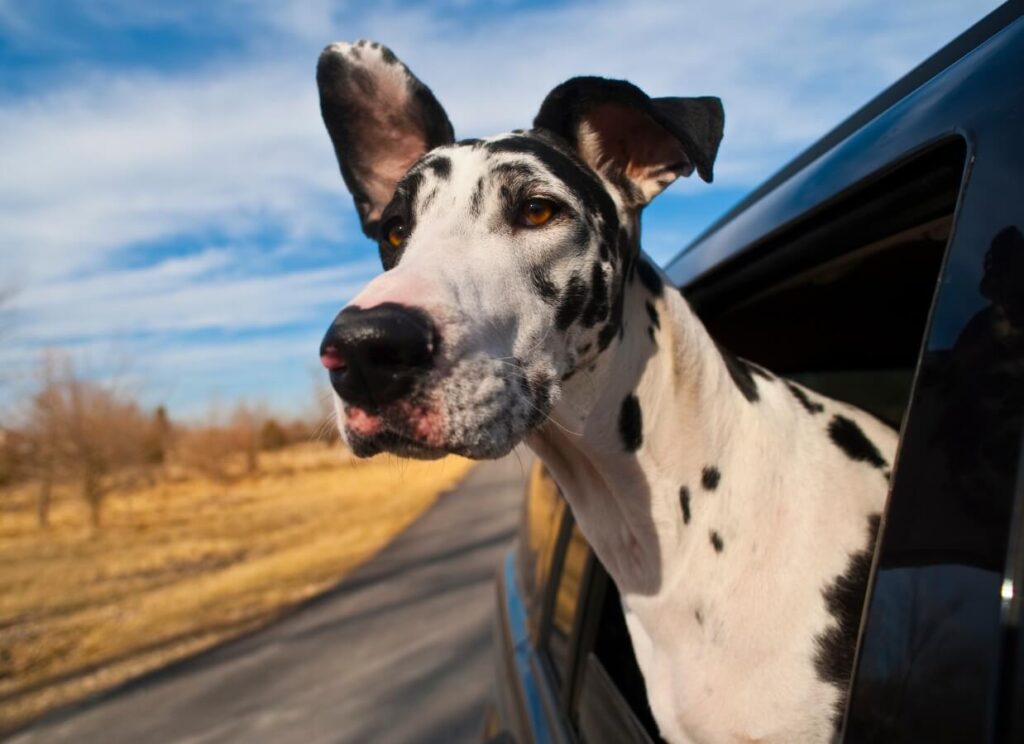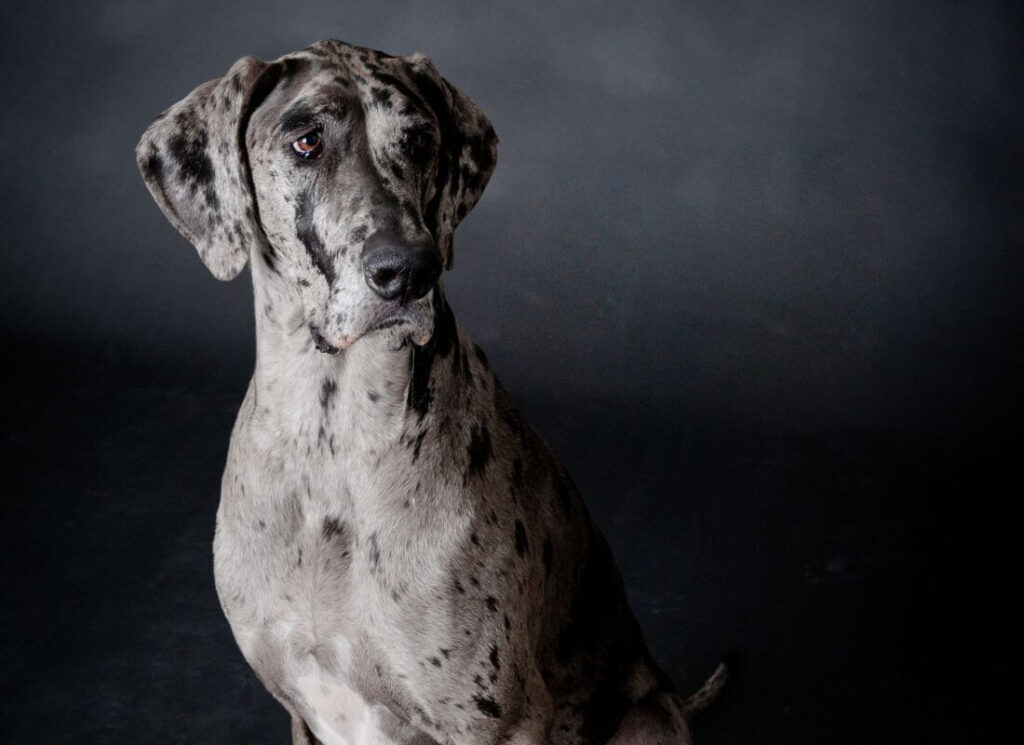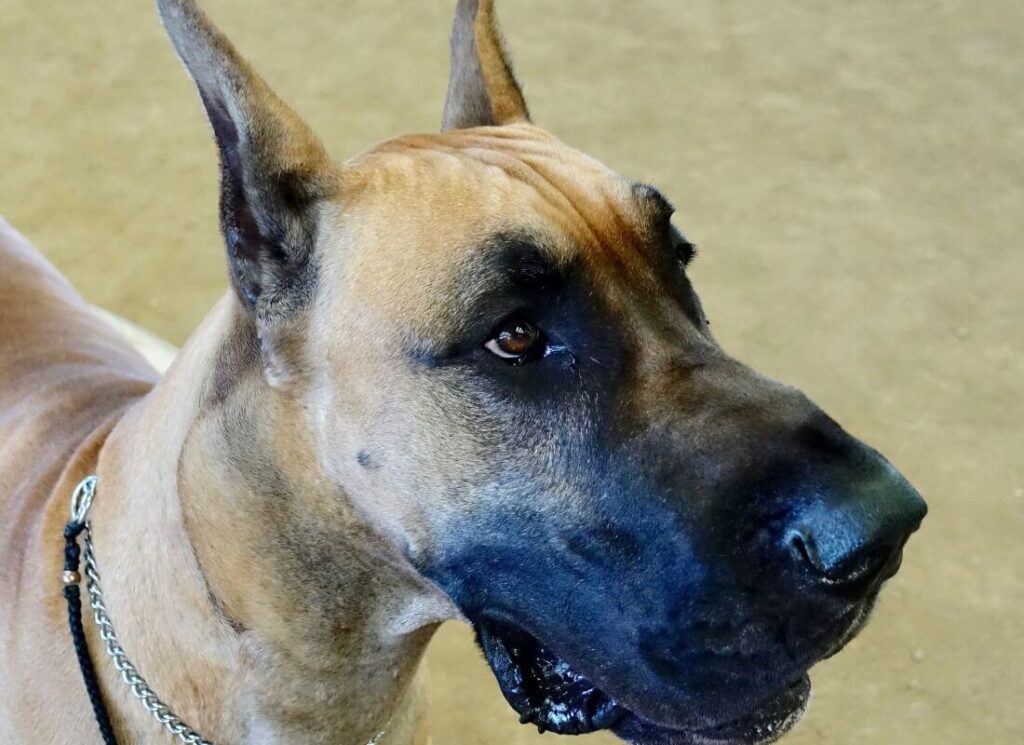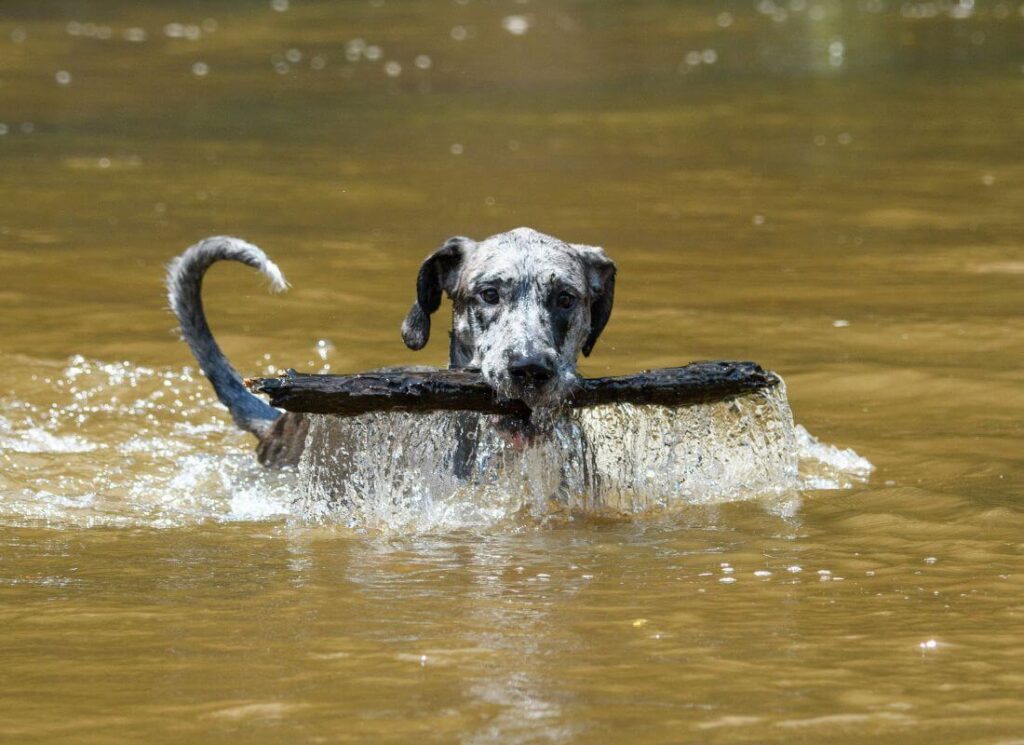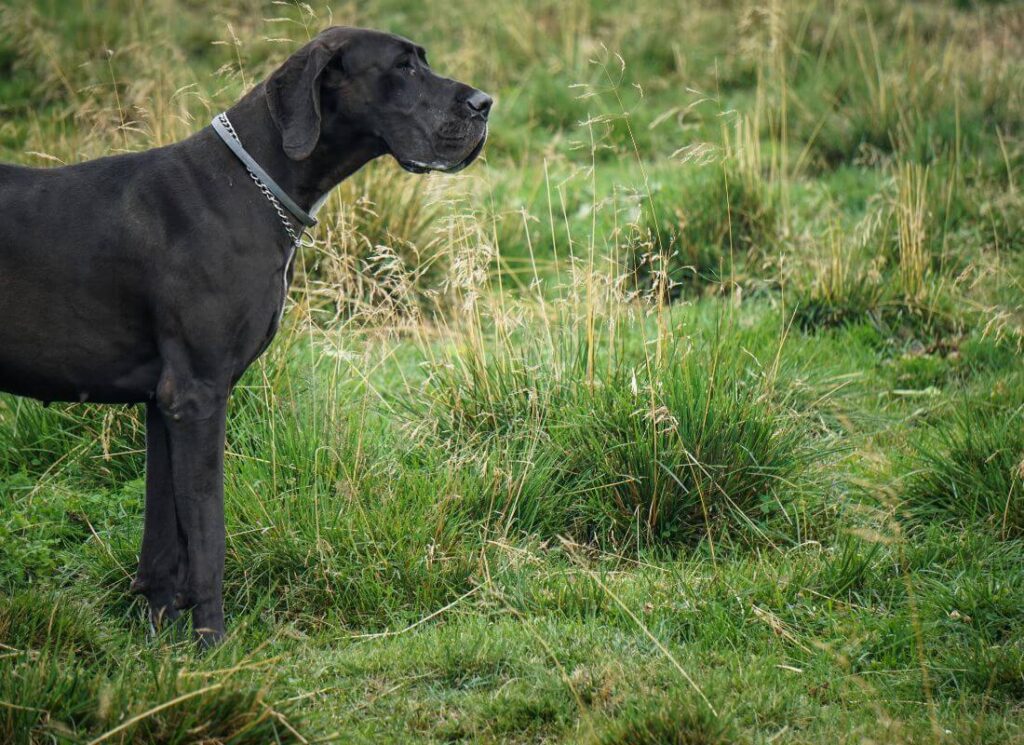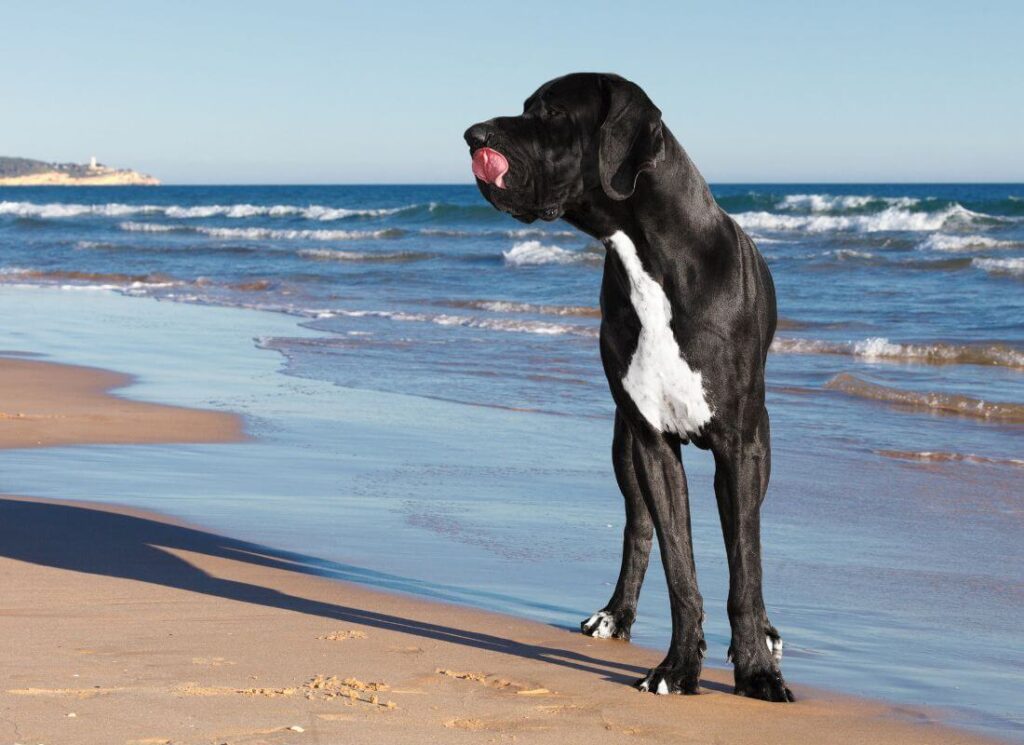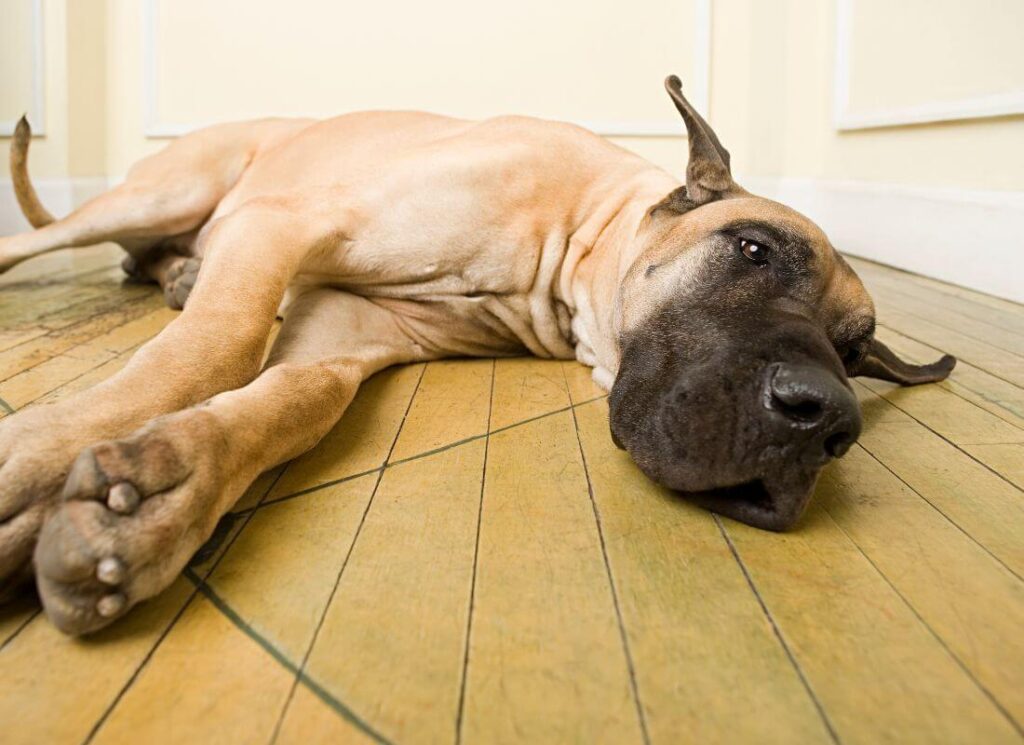Looking for a Great Dane feeding chart with some awesome food information? Curious about the best foods for Great Danes, and what dog food to raise your Dane puppy on?
This is the ULTIMATE everything you need to know about feeding Great Danes blog post. We’re going to cover the following topics:
- The best food for Great Dane Puppies
- Whether adult food or puppy food is best for Great Dane puppies
- How to choose food for Great Danes
- How to prevent knuckling and other orthopedic disorders
- Why nutrition is SO important for Great Danes, especially those under the age of 2!
PRO TIP: This post is huge. Use the table of contents to navigate.
Let’s dig in!
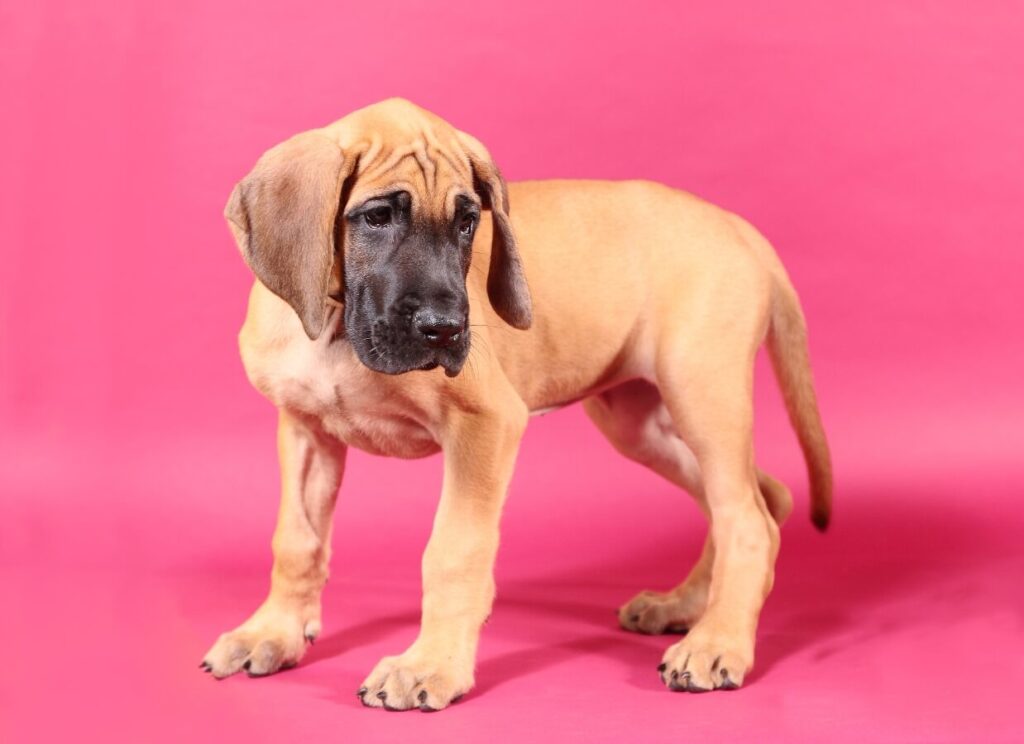
Why is Nutrition SO Important for Great Danes?
Great Danes are a giant breed dog that has sensitive needs when it comes to their bone, joint, muscle, brain, and heart health.
These are not dogs who can survive well on unbalanced or poorly formulated dog foods. As puppies, rapid growth demands exact amounts of calcium, phosphorus, vitamin D and zinc.
Many orthopedic growth disorders in Great Danes are a result of feeding too much calcium, or feeding too much food overall. The results are devastating and may not be apparent until the dog is older and suffering with their mobility and health.
Some foods do not properly support muscle, tendon, or joint health. Other foods are so loaded up with peas, lentils, and legumes that they put heart health at risk.
Researchers have theorized that too much or too little calcium fed to large & giant breed puppies may contribute to increasing their risk for diseases such as brittle bones, Wobblers and Osteosarcoma (Bone Cancer) as adults.
Choosing food for a Great Dane puppy is important, but it’s also very simple when you learn what to look for and how to look past common dog food marketing tactics.
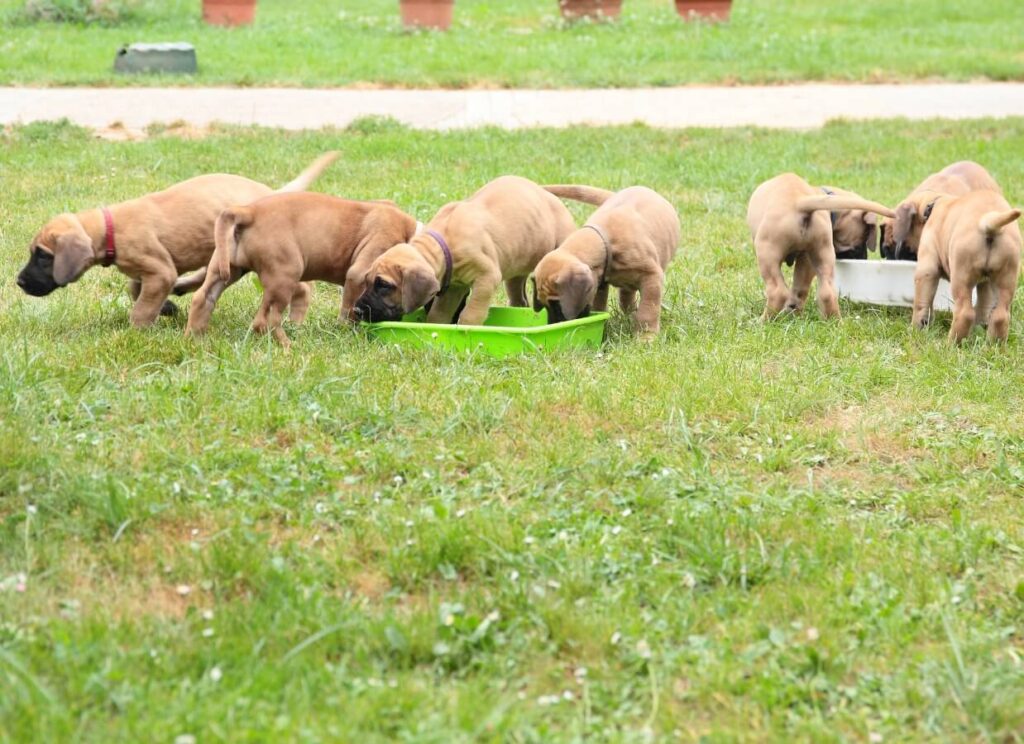
Great Dane Puppy Food & Nutrition
Great Dane Puppies are massive dogs that need a specific diet to ensure they grow at a healthy rate. As mentioned above, Giant breeds are not like other dogs, it’s important to know how to choose the right food.
Before we dig in, it’s important to understand that excess calcium and overfeeding are #1 culprits behind a range of orthopedic growth problems seen in Great Dane puppies.
Because giant breed puppies grow so quickly, the wrong nutrition can be devastating and cause a lifetime of orthopedic problems.
We aren’t trying to scare you here, but this is important. Don’t worry, we’re going to share information with you below on what food to choose!
Here are some of the (often lifetime) health complications associated with feeding the wrong food to Great Dane Puppies:
- Knuckling (Carpal Laxity)
- Panosteitis (growing pains)
- HOD
- Malnutrition
- Poor muscle development
- Flat feet
- Poor overall conformation
- Weak, brittle bones
- N-DCM or ‘Secondary’ DCM (heart failure)
Here are some common health disorders that can be made worse by poor nutrition:
- Heart disease
- Arthritis
- Bloat
- Angular Limb Deformity
- Wobblers Disease
- Kidney & Liver problems
- Low energy
Many of those things also have links to genetics!
When choosing food for a Great Dane puppy, we recommend the following guidelines:
- Grain-inclusive
- 1.2% or less calcium
- Phosphorus close behind
- 1.1 to 1 or 1.2 to 1 CA/PH ratio, no more than 1.3 : 1 if necessary
- 3.5g or less calcium per 1000kCal
- Large or giant breed PUPPY formula OR an appropriately formulated All Life Stages type
- AAFCO statement “Including the growth of large 70+ lb as adult dogs”
A healthy, correctly balanced diet can help prevent devastating orthopedic growth disorders (such as knuckling, panosteitis, HOD, or Dysplasia) and will help make sure that your Great Dane puppy is receiving the nutrition it needs to thrive.
To save you some time, here is our popular list of appropriate veterinary recommended Great Dane puppy foods.
- Purina Pro Plan Large Breed Puppy – any flavor!
- Purina Pro Plan Sensitive Skin & Stomach Large Breed puppy – TOP PICK, salmon-based
- Eukanuba Large Breed Puppy (Great for active and sporting dogs)
- Purina One Large Breed Puppy (Excellent budget option)
- Hill’s Science Diet Puppy Large Breed
- Royal Canin Giant Puppy Dry Dog food (to age 12 months) – TOP PICK, PREMIUM OPTION
- Royal Canin Giant Junior Dry Dog food (8-24 months)
- Purina Large Breed Puppy Chow
Check out THE GIANT DOG FOOD PROJECT to compare brands and values.
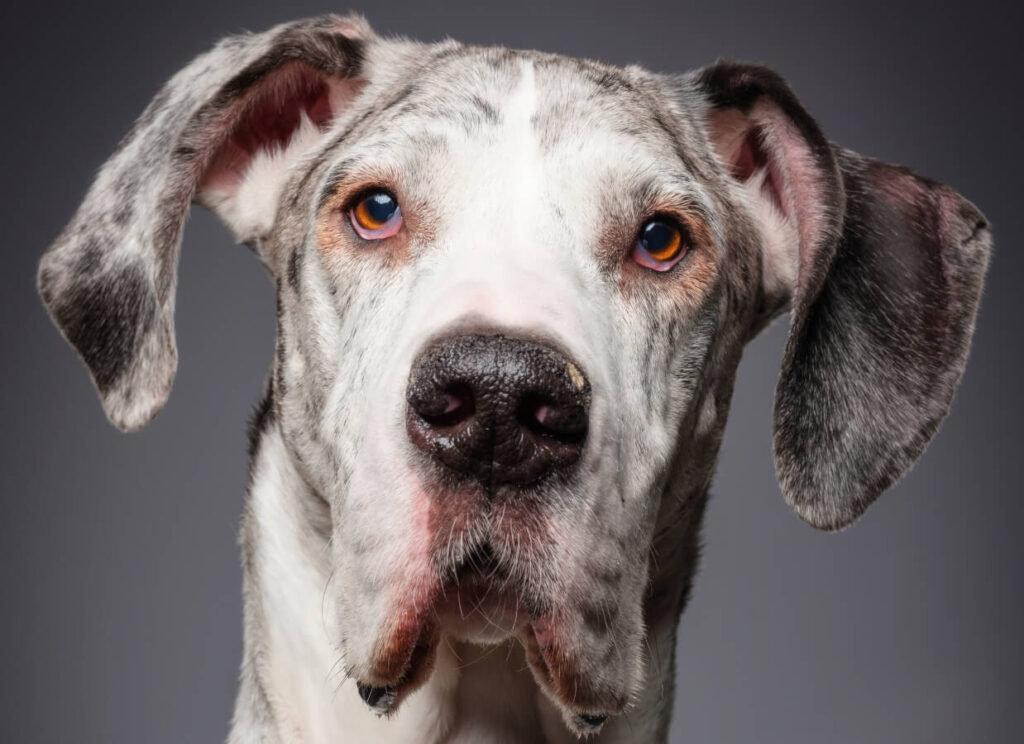
Should Great Dane Puppies Have Adult or Puppy Food?
You may have heard that Great Dane puppies should ONLY have adult food. This information is outdated and potentially dangerous (it’s 2023).
Great Dane puppies should be fed a well-formulated large or giant breed PUPPY or All Life Stages food that was designed specifically to support the slow, even growth of large and giant breed dogs.
That advice to feed adult foods is based on anecdotal evidence and is NOT supported by science.
Most top Great Dane breeders, Board-certified Veterinary Nutritionists, researchers from Cornell, Tufts, and CSU, and the solid majority of practicing veterinarians recommend feeding large or giant breed puppy food to giant breed puppies.
There are a handful of people who are still telling giant breed owners to feed low-protein adult foods. These people include dog owners, a few practicing veterinarians who have not done any continuing education on the topic, and some breeders (many of whom are actually unethical in their other practices, having skipped full OFA health testing or breeding dogs out of standard).
A few old school highly ethical preservation breeders still feed adult food, and this is understandable. They remember the days when we did NOT have safe options in puppy food, and trusting the new standard of practice is a huge leap of faith.
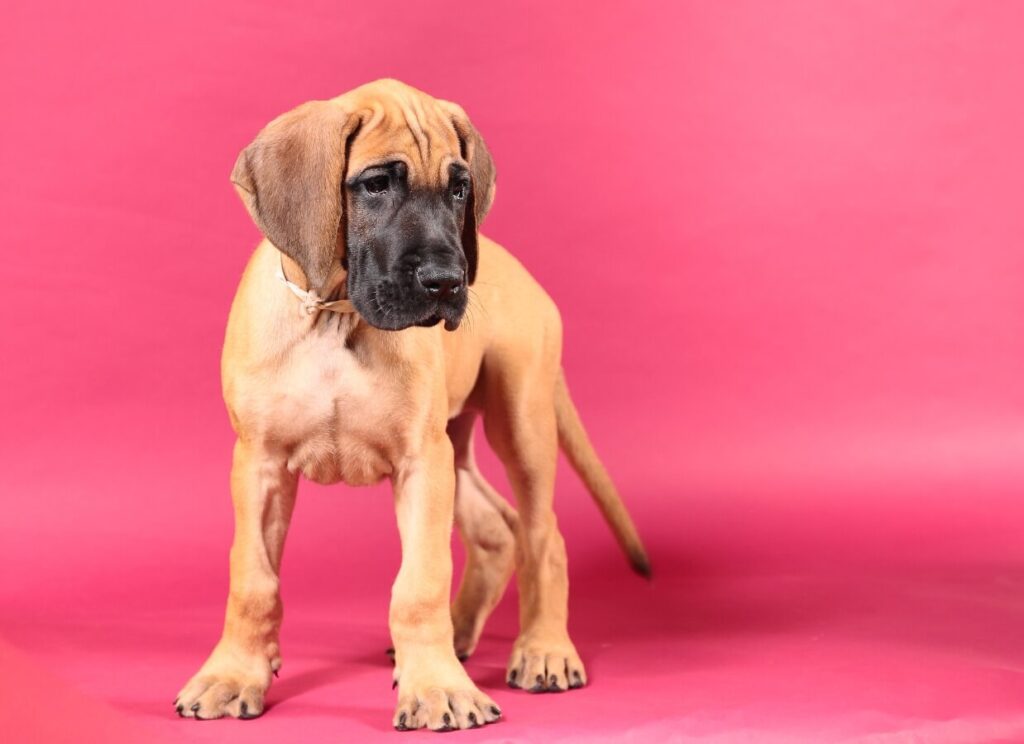
Why Should Great Dane Puppies Have Puppy Food?
Many adult dog foods lack the nutrition that Great Dane puppies need for muscle development, brain health, tendons, and bones.
Lacking this nutrition, puppies may actually eat too many calories and receive too much calcium, two things that are major risk factors for developmental skeletal disorders in giant breed dogs.
We believe that this is a major reason why we see so many teenaged Great Danes who are hopelessly lanky and boney, and many adult Danes who fall apart well before their time.
They are starved for nutrition to support their growth!
Dane puppies will overeat to compensate and then also suffer from chronic loose stools, which are a direct result of overeating. People blame the loose stools on chicken or grain allergies, not realizing that the solution is literally right in front of them.
Science and nutrition in dog food have changed drastically. “Adult food only” is tragically dated advice.
Keep in mind, however, that some puppy foods are DANGEROUS for Great Dane puppies to eat. A traditional high-calorie, high-fat puppy food for smaller dogs is not appropriate.
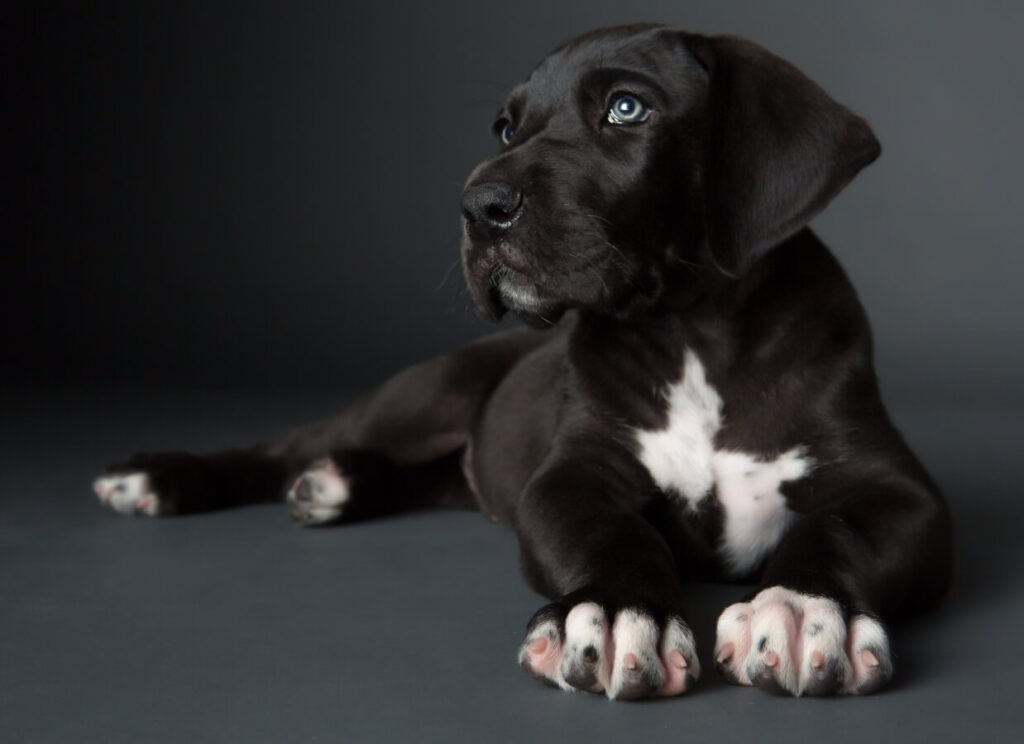
What are the Top Foods for a Great Dane Puppy?
The brand of food you choose matters here, though.
Many brands do NOT have qualified people formulating their foods. They do not participate in research, feeding trials, or truly comprehensive quality control testing. As a result, their puppy formulas may not be reliably correct to support slow growth.
A lot of brands are manufactured in facilities that the company doesn’t even own, spit out from machines that made a different brand the day before.
This is why you will not find brands such as Victor, Taste of the Wild, Blue Buffalo, Diamond, Fromm, Orijen, Earthborn, Whole Hearted, Health Extension, Annamaet, or 4Health on our list. None of them can check every single box when it comes to ethics and dedication to formulation, research, and manufacturing.
The food MUST be correctly balanced as follows:
- Formulated by an on-staff veterinary nutritionist or somebody with a PhD in Animal Nutrition
- Has meat meals or meat by-product meals within the first ingredients (will result in a higher meat content than ‘fresh deboned meat’
- Amino acids correctly balanced and bioavailable, ideally from meat based sources
- Balanced calcium and phosphorus ratios (IMPORTANT!)
- Balanced protein, fat, and carbohydrate levels
- Correct amount of vitamin D, Zinc, and other important nutrients
- Includes grains such as wheat, oats, rice, or corn
- Ideally manufactured in owned facilities
- Formula should have ideally undergone feeding trials and lab testing
To best fit those needs, we recommend a large or giant breed PUPPY food from Pro Plan, Eukanuba, Hill’s, or Royal Canin (the only brands that spend millions of dollars each year investing in feeding trials, board-certified veterinary nutritionists, and peer-reviewed research).
You can use the search tool at the Giant Dog Food Project as well, to compare brands head to head.
If you have any questions about what kind of dog food is best for your Great Dane Puppy to eat, read our blog post HERE or continue below (we’ve included recommendations for our favorites):
Most Dane pups will need to eat between 3 and 12 cups of large breed puppy food each day. The actual amount depends on their activity level and the food you choose! We outline more of this below.
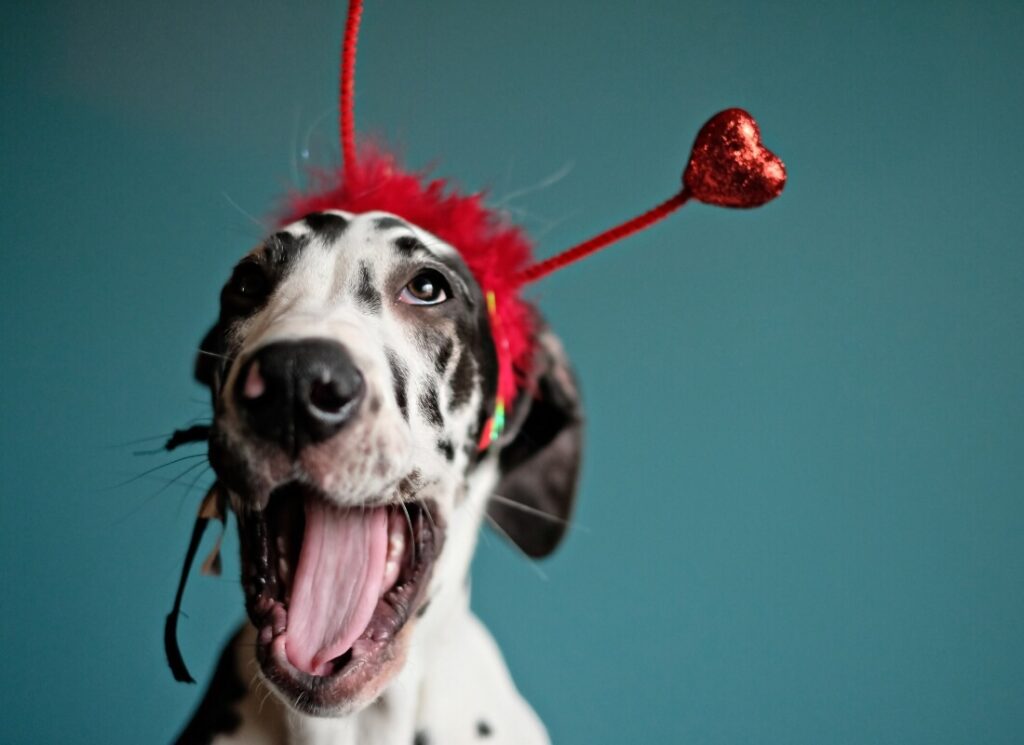
Kibbles that meet WSAVA recommendations
The World Small Animal Veterinary Association (WSAVA) is a non-profit organization that provides common-sense recommendations. WSAVA does not endorse or recommend any specific brand of food, and their scientific efforts go far beyond nutrition into every aspect of small animal health.
Any food brand can donate to and support the WSAVA, however, only a few do.
Surprisingly, many kibble manufacturers do not meet the following common-sense guidelines:
- The company employs a DACVN/board-certified Veterinary Nutritionist or PhD in Animal Nutrition, and that person is there to formulate and test the diets.
- They utilize AAFCO feeding trials to prove their formulation, especially the one you want to feed, in real life (not just on paper).
- The company participates in scientific research and contributes to common peer-reviewed studies.
- They own and operate their own facilities (no co-packing) and have strict supply chain protocols, sourcing ethics, sourcing protocols and quality control.
- The food has a nutrition adequacy statement from AAFCO, ideally indicating that the food was substantiated in feeding trails.
Call your food company and ask these questions. Look past their marketing department and get real answers from them about their practices.
Tread cautiously with the places you receive nutrition information from. Many dog owners, influencers and “pet nutritionists” are spreading dangerous misinformation.
For more helpful information about canine nutrition and manufacturer practices, search for your brand at the Pet Nutrition Alliance! They’ve established a database that answers important and relevant questions for each company that you might choose from.
You can also visit the Tufts University Petfoodology Blog for information about corn, by-products, DCM, and other nutrition-related topics.
Pet Vet Corner on Facebook has a fantastic nutrition file (search for the group and join).
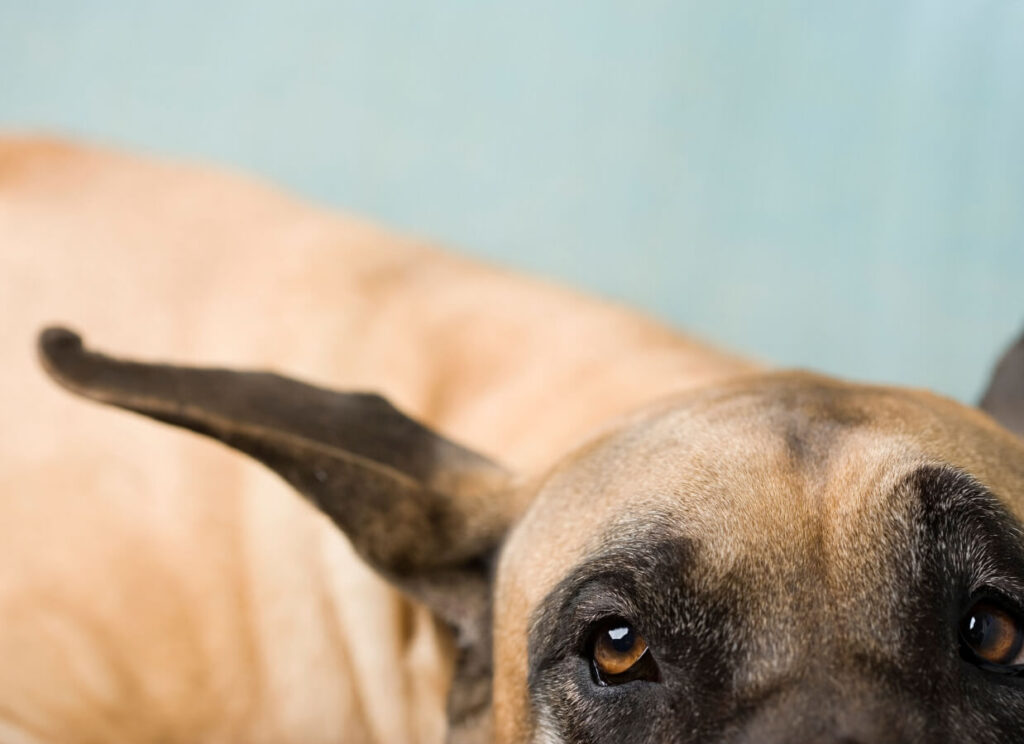
When to Transition to Adult Food
When your Great Dane is 18-24 months old, it’s time to transition to an adult formula. Ideally, the transition should happen no sooner than 24 months but can happen after 18 months if early spay/neuter was elected.
Remember, puppy foods are higher in calories, fat, and protein and may be too rich for mature adult dogs or those that have been spayed/neutered. Great Danes are not fully mature until age 2.5-3 years.
Click below to see our favorite adult foods for Great Danes:
- Purina Pro Plan Sensitive Skin and Stomach Large Breed (Salmon based, chicken free)
- Purina Pro Plan Large Breed Shredded Chicken & Rice (Large Pieces & Chicken Shreds!)
- Purina Pro Plan Large Breed Weight Management (Get the weight off)
- Purina Pro Plan Large Breed Bright Mind Age 7+ (for Senior Great Danes)
- Purina Pro Plan Giant Breed (Hard to find, might be discontinued)
- Royal Canin Giant Breed (Amazing for dogs with chronic loose stools, TOP TIER)
- Eukanuba Large Breed (Great for active and sport dogs)
- Purina One Smart Blend Large Breed (Fantastic budget-friendly option)
- Hill’s Science Diet Large Breed Beef & Rice
- Purina Pro Plan 30/20 Sport Beef & Bison
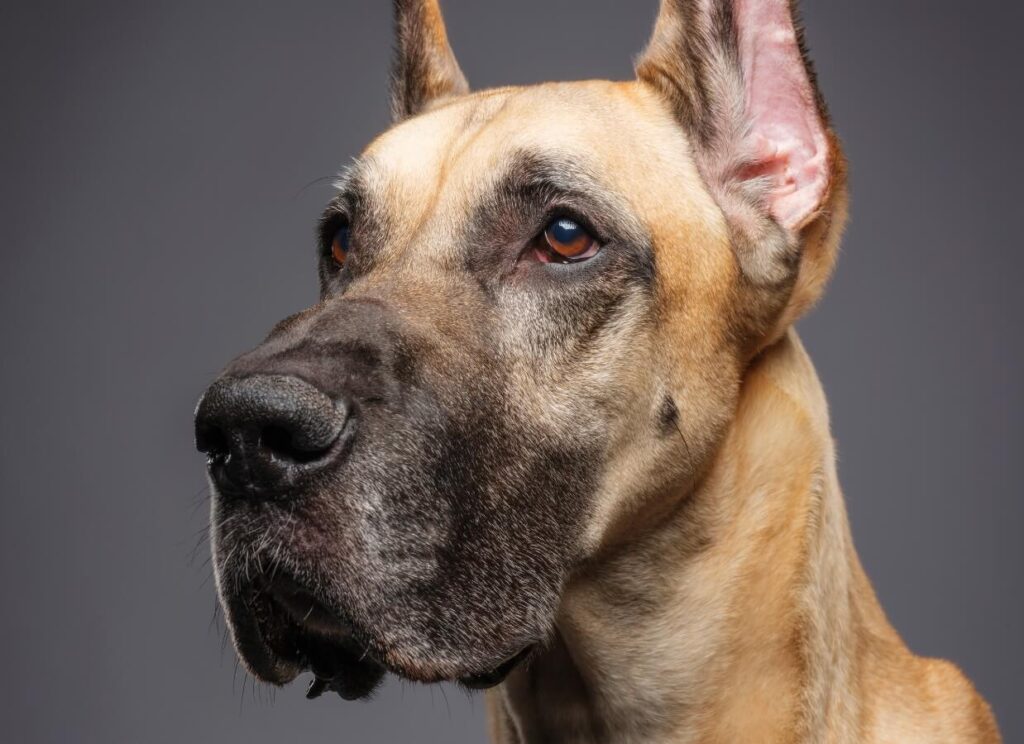
How Much Should a Great Dane Puppy Eat?
Young Great Danes should eat three to four small meals per day, rather than one large meal.
Encourage slow eating, throughout life, to reduce bloat risk.
Most quality Great Dane food will indicate a rough estimate based on age or weight, which is a good baseline for determining how much food daily will be required.
Your Great Dane puppy is going to eat a lot of food! New Great Dane owners may be alarmed at the intake but shouldn’t be.
It’s important to note, however, that orthopedic growth disorders can be triggered by overfeeding, even if the food is correctly balanced! Monitor your dog’s intake and don’t let them gorge on food.
Lean is best! It is normal to see some ribs on Great Dane puppies.
While it’s true that too much kibble can actually cause a Great Dane puppy to experience gastrointestinal distress (and loose stools), too little kibble can hamper energy as well as good muscle and bone development.
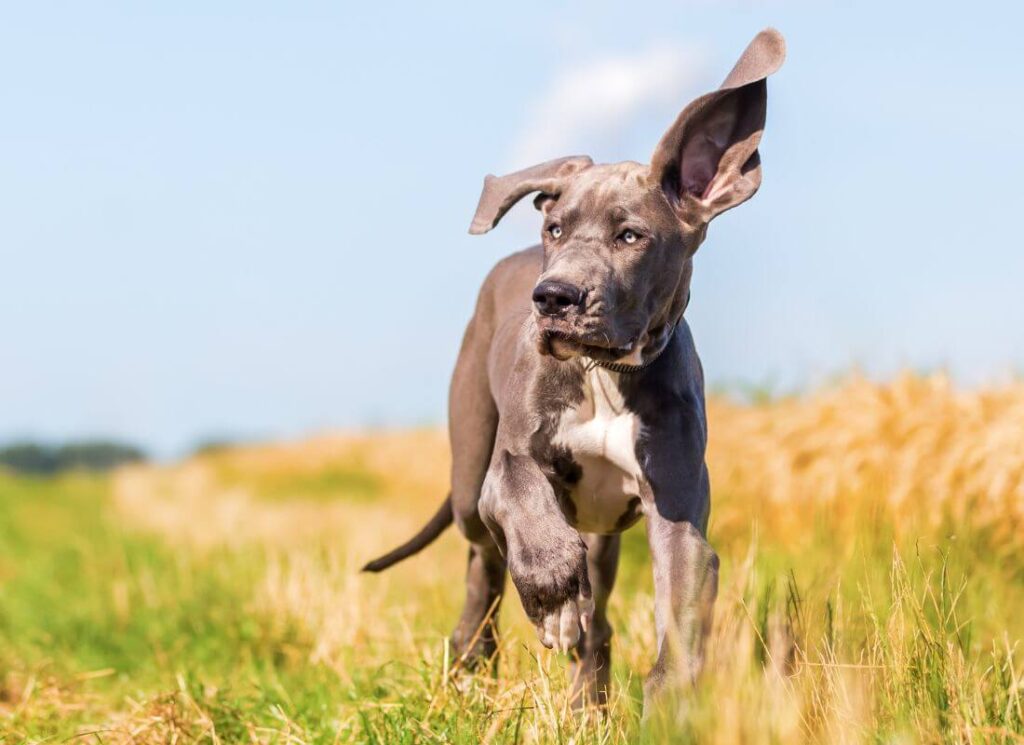
Healthy Body Condition in Great Dane Puppies
It is normal for Great Dane puppies to have a little rib showing!
As long as they are bright, active, curious, and energetic, they are doing great.A Great Dane Puppy should never be overfed to encourage fast and explosive growth!
Too much nutrition, overfeeding, and too many calories can lead to knuckling, HOD, Panosteitis, and poor overall structure, no matter what formula or food brand you choose.
When looking at a Great Dane feeding chart to determine roughly how much to offer your 12-week-old Great Dane puppy, it’s important to remember that the information is simply a guideline. Good feeding practices involve intuition and close monitoring!
We recommend referencing our Great Dane puppy growth chart for more information on actual growth!
If you have any questions about how much food to feed your Great Dane puppy, please consult your veterinarian, read the feeding chart on your kibble bag, and reference our Great Dane feeding chart below.
Want to avoid overfeeding your dog? Check out this feeding hack!
| Age | Timing | Amount |
| Puppies under 12 weeks | 3x/day | 2-4 cups/day |
| Puppies 12-24 weeks old | 3x/day | 3-6 cups/day |
| Puppies 24 + weeks (6 months) or older | 2x/day | 5-10 cups/day |
| Puppies 12-18 months | 2x/day | 6-12 cups/day |
| Adults 18+ Months | 2x/day | 4-8 cups/day |
How to Feed a Great Dane Puppy
When it comes to Great Dane puppies, how you feed them is just as important as what you feed them.
Puppies have small stomachs and need to eat several small meals throughout the day, rather than one large meal. They will also need frequent potty breaks as their digestive systems are still very immature.
We recommend that your Great Dane eats from a using stainless steel bowl. These are easy to sanitize and can help prevent puppy acne!
Frequent smaller meals can help prevent bloat, a potentially deadly condition that can occur in large and giant breeds.
To avoid creating a ‘picky eater’, do not start adding toppers as a form of bribery!
For puppies under 3-5 months of age, we recommend a loose free feeding schedule where you put food down 3x/day but leave in the bowl what they don’t finish, so they can graze. Don’t overfeed.
After 5 months of age, offer food 3x/day and pick the bowl up. Pup will learn to finish what is offered.
Around 7-10 months of age, many Danes need less food. People sometimes believe this means their dog has become picky. That’s not true! Just feed less.
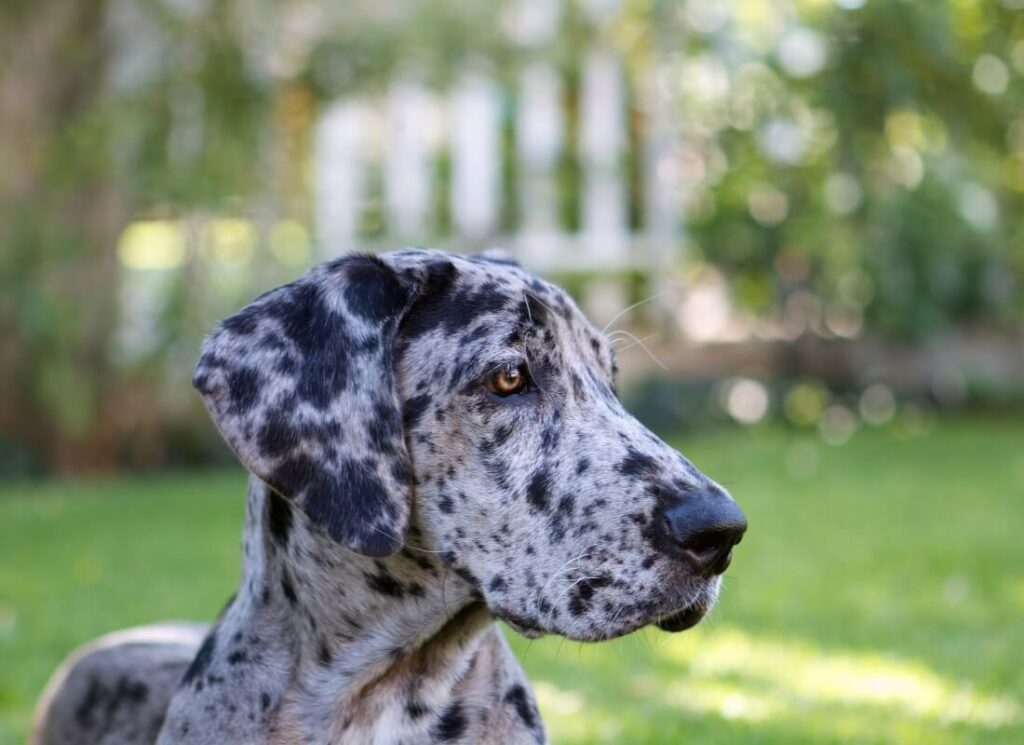
Using Kibble for Training
Another way to feed your Great Dane is to offer their pre-rationed kibble and healthy balanced toppers as training treats!
Keep them in a treat pouch (this is our favorite one) and use them throughout the day to reward your dog for doing things that you like.
Engaging with you, sitting, laying down, and coming when called are great ways to encourage positive behaviors!
Resting before & after meals has never been shown to prevent bloat. As a matter of fact, most dogs who experience bloat do so while resting and on an empty stomach.
It’s ok for your puppy to have training rewards while playing with you!
Science in Dog Food
After years of diligent research, I’ve personally come to realize that the answer to dog food had been in front of me all along.
The unfortunate truth is that many dog food brands are spending more money on marketing than they are on formulating their foods, researching how nutrition affects the body, and contributing to peer-reviewed science that addresses giant breed growth, cancer, wobblers, heart disease, and more.
That marketing is designed to mislead us. For example, ingredient splitting is a common practice of certain brands. Ingredient splitting is completely legal and can make dog food look like an organic meat feast when the truth is that it’s nothing more than meat-flavored peas.
Fresh deboned meats, for example, are roughly 70% water. Pair that with ingredient splitting and a formulation that came from a computer (not a veterinary nutritionist), and well…you’re often paying a premium price for fancy marketing.
You may be inclined to think that the ‘holistic’, ‘super premium’, ‘human grade’ choice at the pet store is the healthier option. Keep in mind that those are unregulated marketing terms with no legal definition.
The ingredients list doesn’t tell you the whole story, and that’s why reading it shouldn’t be your primary factor in choosing dog foods.
You may be ‘grossed out’ by things such as ‘by-product meal’ or ‘meat meal’, but those ingredients are actually more nutritious and more species appropriate than deboned meat!
Read more about Ingredient Splitting Here
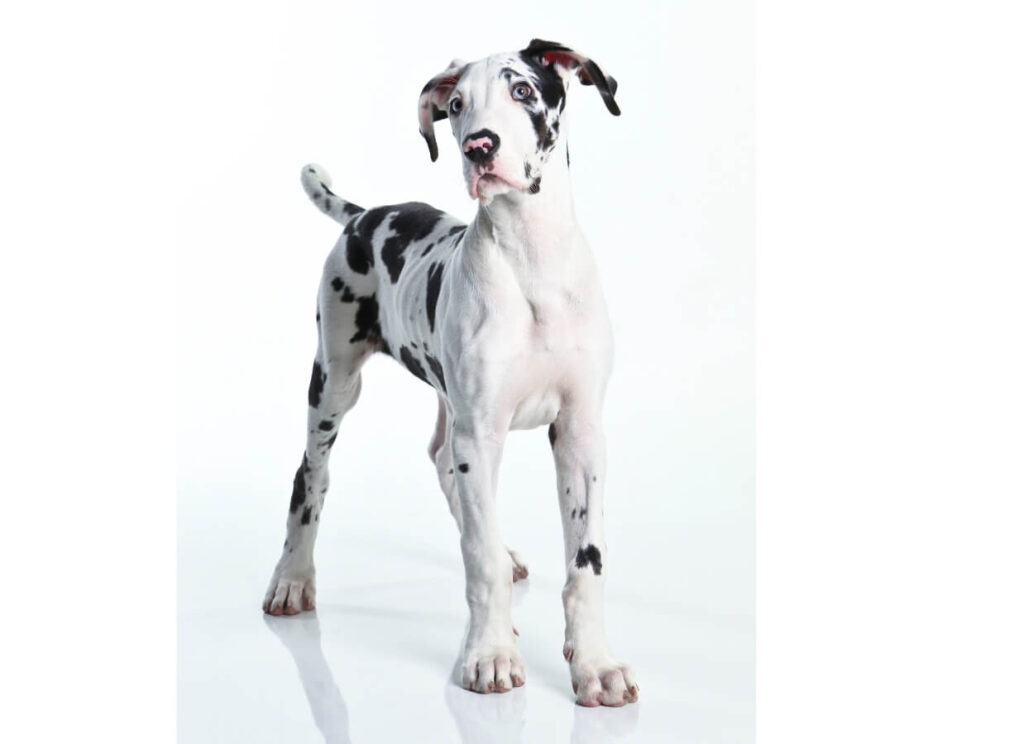
Holistic & Natural Pet Foods
Many Great Dane owners rely on kibble brands from companies such as Fromm, Zignature, Nutro, Victor, Nulo, 4Health, Farmina, Solid Gold, Taste of the Wild, Life’s Abundance, Earthborn, Honest Kitchen, Canine Caviar, Acana, Orijen, Gentle Giants, Diamond Natural’s and Costco/Kirklands.
Search for your brand at the Pet Nutrition Alliance. See how they stack up against other brands that were asked a few simple questions. If they didn’t answer or refused to answer, find a different brand.
The brands we’ve listed in the paragraph above are NOT formulated by on-staff veterinary nutritionists, and we don’t recommend a single one of them.
Fromm is formulated by a chemical engineer.
Victor is formulated by a guy with a science degree and simple online certificate in ‘nutrition’.
Diamond (which makes Diamond, Costco, 4Health, Taste of the Wild, Nutra Nuggets, and others) is a giant co-packing company. They use a single off-site, marginally qualified consultant and a ‘proprietary formulation technology’ (a computer program or spreadsheet).
Midwestern pet foods (which makes Earthborn, Sportmix, Unrefined, Venture, and Wholesomes) is another giant company with no Veterinary Nutritionist on staff (not to mention repeated issues with aflatoxins and salmonella).
Unrefined is an excellent example of a ‘premium’ label that uses a lot of fancy marketing words and makes you think it’s a small, family-owned healthy option. It’s formulated, packed, and shipped along side several other Midwestern Pet Foods brands, each targeting different demographics.
These are huge companies, selling their products as ‘premium’, at a premium price point, and not a single bag of it is backed by legitimate feeding trials or peer reviewed research.
Every single one of those companies has also had proven cases of DCM, a devastating heart disease that can be caused by poorly formulated nutrition. Acana and Orijen (Champion pet foods) are among brands with some of the highest number of cases.
If you want to learn more about the pet food industry, here are some fantastic additional resources!
The Petfoodology Nutrition Blog
Royal Canin Giant Breed Dog Food Review
Identity Pet Foods ‘Understanding DCM’ (I don’t love that this small, upstart brand is anti-kibble, uses a co-packer, has no feeding trials, does not provide AAFCO statements, and does not staff a veterinary nutritionist as of 2022, but I do love what they are trying to do as a whole and this DCM article is ON POINT!)
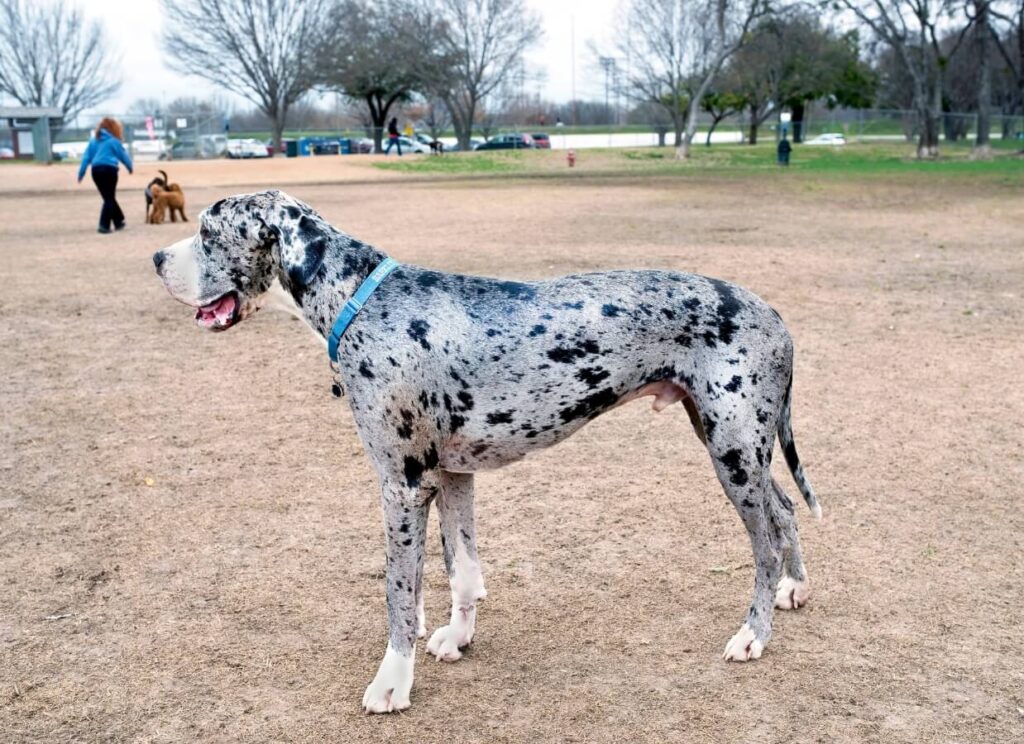
Kibble Brands to Avoid
While there are many brands to avoid, these brands are absolutely on the ‘do not fly’ list. We’ve reviewed some of them below for your convenience.
- Gentle Giants
- Life’s Abundance
- Grain-Free foods
- Boutique foods with a small market share
- Any food that is ‘vegan’, ‘plant based’ or ‘cricket based’ (NEW EXCEPTION: ROOT LAB may be acceptable)
- Any food with 2 or more types or forms of PEAS, LENTILS, or LEGUMES listed in the ingredients. For example peas, dried peas, pea protein, pea fiber, pea flour, split peas, yellow peas, green peas, lentils, whole lentils, lentil fiber, etc.)
- Any food that has a lot of peas, potatoes, legumes, garbanzo beans, beans, sweet potatoes, or chickpeas in general
- Boutique, unproven food brands with humanized marketing (Keto, Paleo, Low Carb, etc.)
- Any one of the 300-400 new boutique food brands in the U.S. each year
What about Dog Food Advisor?
Many people turn to the ‘Dog Food Advisor’ blog to make decisions about what food to feed.
While that blog provides some interesting analysis about certain kibbles, it’s important to note that the blog is run by a dentist…NOT a Veterinarian or a Canine Nutritionist with any kind of legitimate, commonly accepted credentials. The blog is extremely profitable, as it is littered with affiliate links to purchase foods.
The rating system is made up, and has been changed to match current trends.
If you don’t trust your veterinarian because they are “not a nutritionist”, why are you trusting pet store employees, dog owners, the Dog Food Advisor, influencers, and people who obtained easy pay-for-purchase ‘pet nutritionist’ certificates on the internet?
If you are looking for a nutrition blog that uses science and actual research, not marketing and theories, visit PETFOODOLOGY! It’s run by Tufts University and has many helpful topics.
At Hello Danes, we follow, promote, and share the advice given by board-certified veterinary nutritionists.

Adult Great Dane Dog Food
Adult Great Danes still require dedication to their nutrition.
As an adult, your Great Dane will need a quality dog food that is rich in animal protein to maintain lean muscle mass.
The most appropriate meats that you want to see in the dry dog food you choose include meat meals and meat by-product meals. We recommend chicken, salmon, or beef.
Chicken allergies are wildly over-diagnosed by dog owners. Contrary to popular belief, Great Danes are NOT sensitive to chicken!
They are, however, sensitive to poor quality diets, environmental factors, overfeeding, and issues related to gut health that are resolved through other means.
Avoid lamb (it’s incredibly difficult for dog food manufacturers to work with, and may cause nutrient deficiencies) and exotic meats such as bison, cod, quail, kangaroo, or yak. Exotic meats are not well researched for small companion animals.
Rendered meat meals were shown in bloat studies to reduce the risk of bloat by 53%!
Meat meals of any type (including by-product meals) include a rendered form of whole prey. That means that the ingredient includes things such as meat, tissue, cartilage, bone, and organ.
While this may sound gross to you, these things are loved in parts of the world that don’t waste any part of an animal after slaughter. They are also the same things that make up a correctly balanced bowl of raw dog food: necks, feet, guts, skin, and fat.
Raw feeders know that dogs need and want by-products in their diet! They go straight for the organs, will crunch up the bones and love to chew up feet, necks and yes, eyeballs.
Choose a kibble formulated with your dog in mind, not your personal taste.
Transition to a comparable adult formula between 18-24 months.
- Purina Pro Plan Sensitive Skin and Stomach Large Breed (Salmon based, chicken free)
- Purina Pro Plan Large Breed Shredded Chicken & Rice (Large Pieces & Chicken Shreds!)
- Purina Pro Plan Large Breed Weight Management (Get the weight off)
- Purina Pro Plan Large Breed Bright Mind Age 7+ (for Senior Great Danes)
- Purina Pro Plan Giant Breed (Hard to find, might be discontinued)
- Royal Canin Giant Breed (Amazing for dogs with chronic loose stools, TOP TIER)
- Eukanuba Large Breed (Great for active and sport dogs)
- Purina One Smart Blend Large Breed (Fantastic budget-friendly option)
- Hill’s Science Diet Large Breed Beef & Rice
- Purina Pro Plan 30/20 Sport Beef & Bison
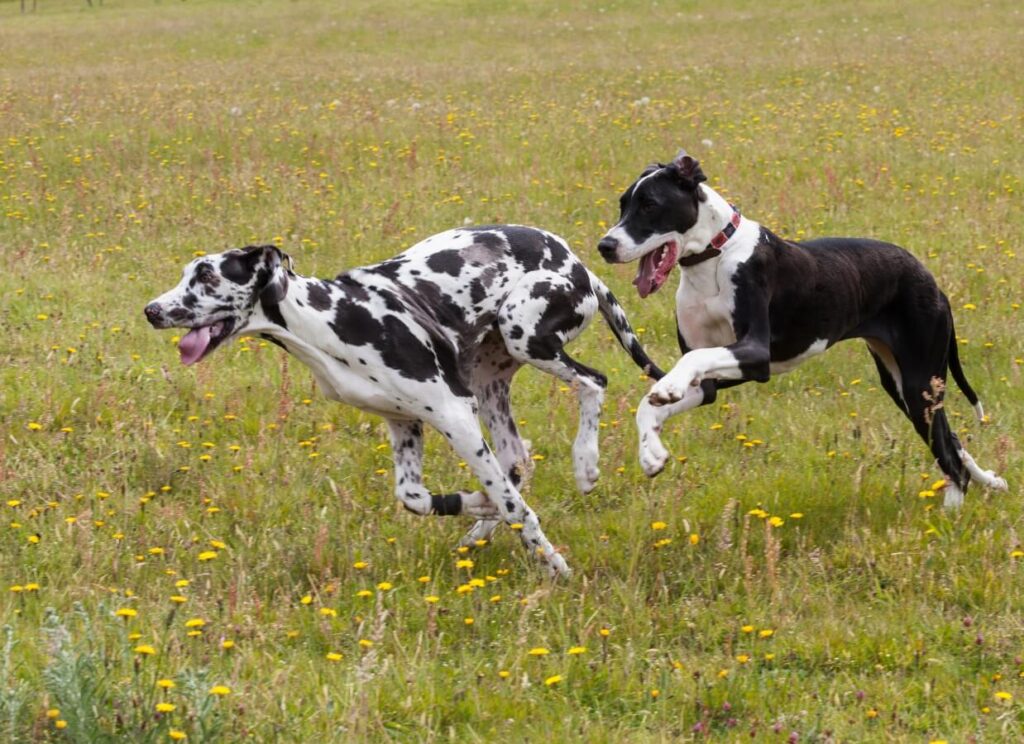
Fiber & Fresh Foods for Great Danes
Fiber, fresh foods, and canned foods have been shown in studies to reduce bloat risk!
The safest topper you can add to your dog’s food is a canned version of their kibble. This has been shown to reduce bloat risk, will be correctly balanced, is tasty, provides hydration, and will be free of salmonella and e.coli.
When offering puppies canned food, make sure you are choosing the large breed puppy version.
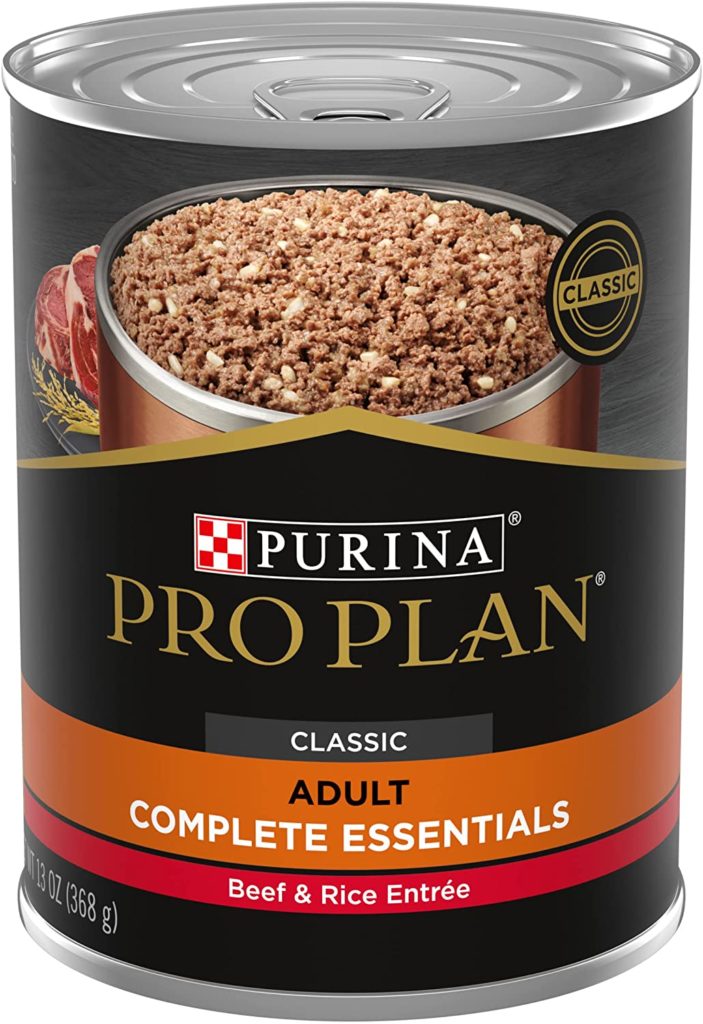


You can also choose any of the following:
- Commercially balanced raw food, such as RAWS PAWS PET FOOD
- Olewo Carrots (rehydrate before serving, they don’t need much)
- Dr. Harvey’s (keep to less than 4% of the overall diet)
- Balanced homemade food (read more HERE)
We love Olewo’ Carrots (rehydrated) which are great for your dog’s stomach and overall gut health. 1 TBSP of dried Olewo Carrots will make over a half cup of fresh carrots to mix in with the kibble you feed your Great Dane.
Olewo Carrots work BETTER than pumpkin and are easier to store, too!
We also like Dr. Harvey’s for easy, healthy fiber & fresh food toppers!
While some of these are technically made to be served as a whole meal with raw meat, they actually make a great ‘topper’ (less than 4-10% of all intake) for kibble and well-balanced raw diets.
Rehydrate a scoop or two of this with water! Dogs love it and the bag lasts a long time, too.
Can Great Danes have Grain-Free Food?
Grain-inclusive kibble formulas are best for Great Dane, as they are less likely to be filled with peas, potatoes, legumes, and pea protein that can throw off the balance of important amino acids.
These amino acids, including taurine, are necessary for heart health. Many grain-free food options are nothing more than meat-flavored peas.
Many dogs have been diagnosed with DCM (heart failure) caused by grain-free foods and foods of all types that were not formulated by veterinary nutritionists.
Read our blog post on grain-free dog foods and Great Dane feeding here.
This information is important for all dog owners and all dog breeds, too!
Adding taurine or grains to grain-free kibble doesn’t solve a problem that originated with poor kibble formulation to begin with.
Is Dr. Judy Morgan Legitimate?
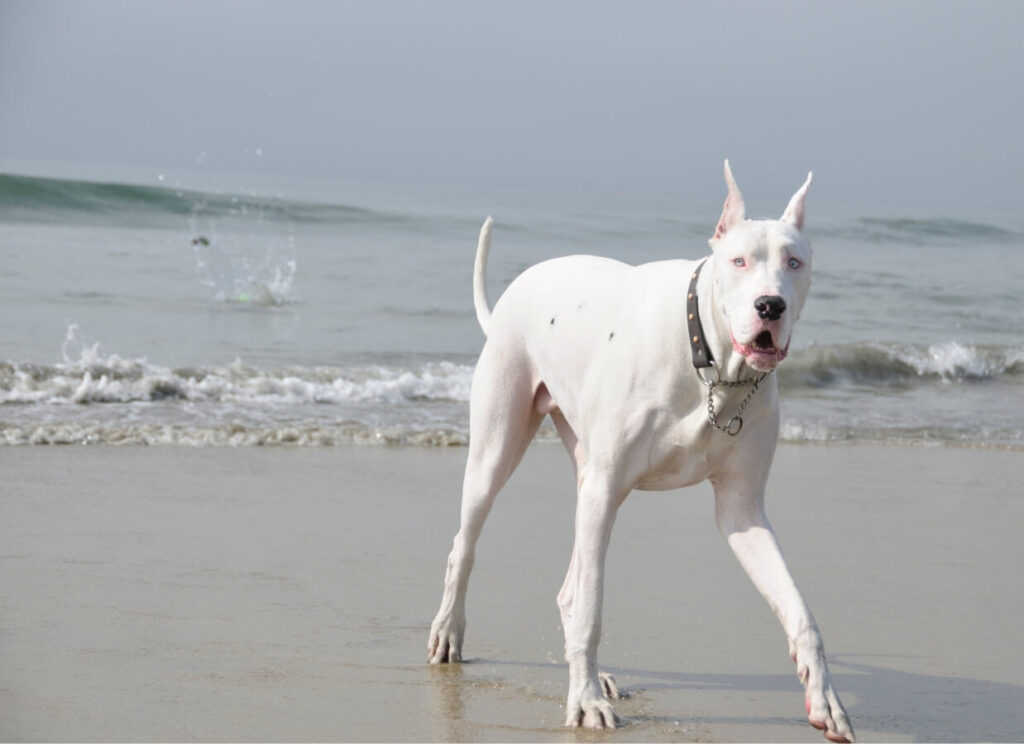
Supplements for Great Danes
Great Danes can suffer from joint problems.
We recommend the addition of fish oil and Dasaquin or Green Lipped mussel, especially if your kibble food does not include these supplements in the ingredients list.
A quality science-backed food with meat meal or meat by-product meal (such as Royal Canin Giant Breed Adult) will contain joint support!
Big dogs benefit from the addition of these, and probiotics for their health.
See our list of recommended supplements here:
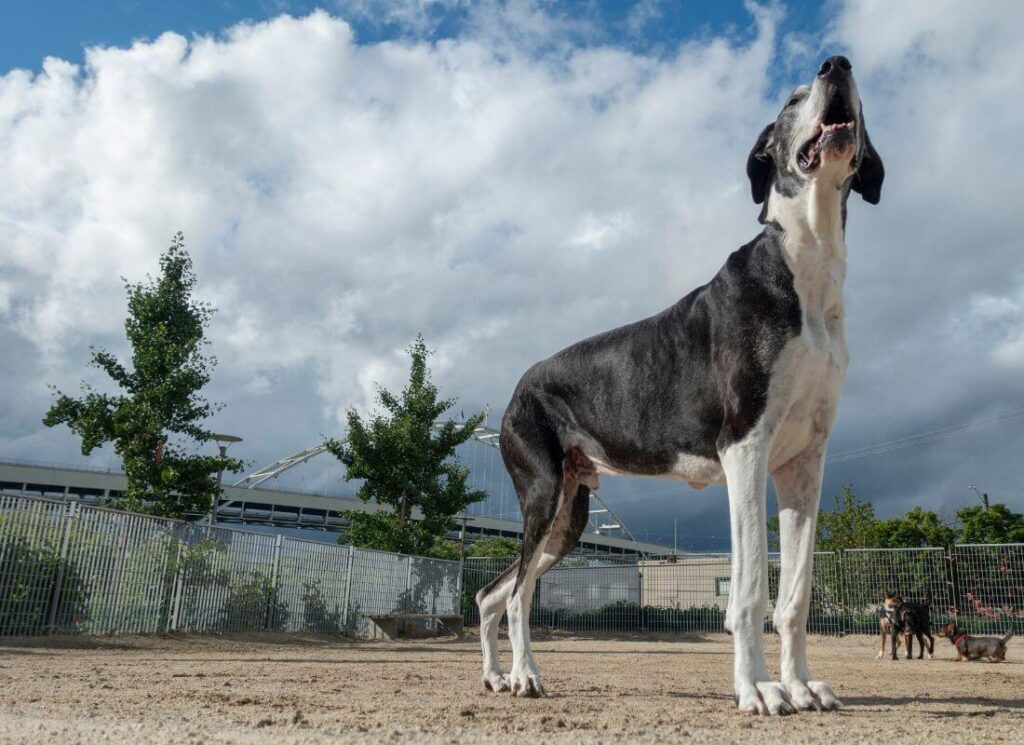
Home-Cooked Diets for Great Danes
Home-cooked diets are rarely healthy and can be exceedingly difficult to get right.
Balance It is a great website for determining if you are formulating your home-cooked diet for your Great Dane correctly. Test your recipe over there!
We haven’t found a dog food recipe on Pinterest yet that was balanced correctly.
You’ll likely find that the very common homemade Great Dane food diet consisting of ground meat, rice, and veggies is horribly deficient. Even recipes created by influencers and veterinarians (such as the famous ‘pup loaf’ by holistic influencer Judy Morgan) is dangerous.
I plugged Dr. Judy Morgan’s pup loaf recipe into Balance It, and the system could NOT resolve the recipe as-is (meaning, it’s unbalanced). It also indicated that the recipe could result in dangerous levels of vitamin D!

What your Great Dane eats will affect their health, and unfortunately, most home cooks have little to no credible background in canine nutrition!
An unbalanced home-cooked diet may be missing key nutrients, proteins, and amino acids that are necessary for a long and robust life.
Great Dane dogs are particularly susceptible to health issues of the heart and bones; an incorrectly formulated home-cooked diet for a Great Dane can be exceptionally dangerous.
Many veterinarians say that brittle bones are a very common complication associated with clients who make their dogs food at home.
One study found that nearly all of the 200 recipes they tested had nutrient deficiencies. (READ THAT STUDY HERE).
We personally don’t think it’s worth the risk.
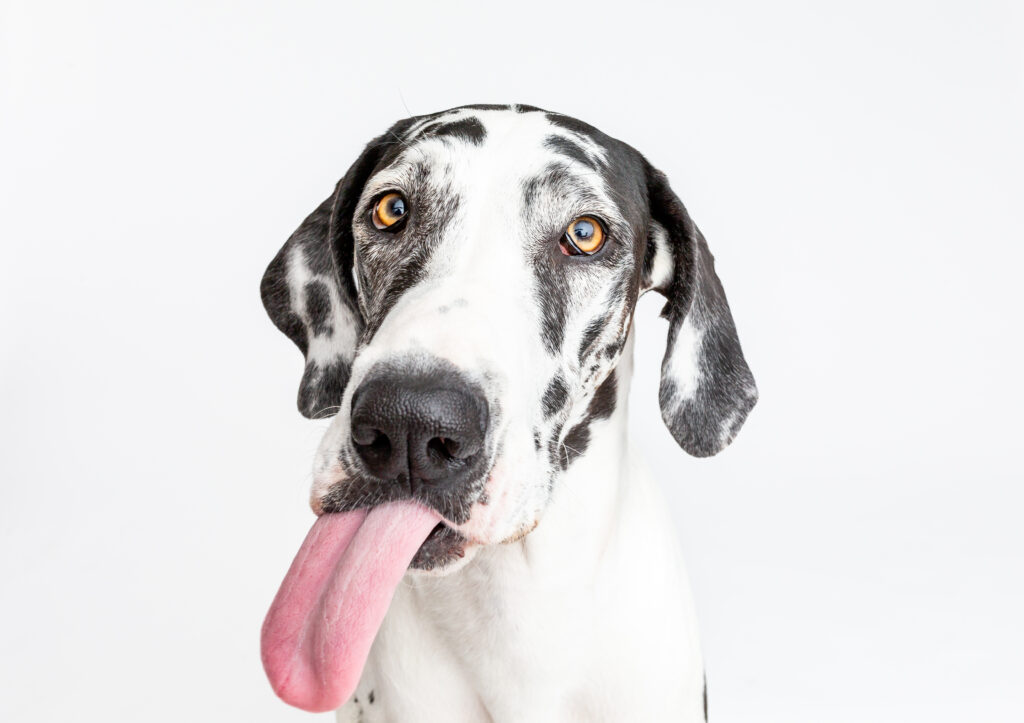
Home Cooked Dog Food Alternatives
That’s not to say that it cannot be done! As a matter of fact, with the help of a board-certified Veterinary Nutritionist and the website listed above (Balance It) you can take full control over what your dog eats.
If you want to offer food that is similar to a home-cooked diet, we recommend looking into Just Food For Dogs.
This fresh food option for Great Danes is a professionally formulated alternative to DIY. The jury is out on if it fully and truly meets the WSAVA guidelines above. However, it is a tested food with a respectable staff of formulators behind it.
There is nothing wrong with kibble. Don’t feel pressured or guilted into spending large amounts of money on ‘fresh’ or ‘holistic’ options.
Just Food For Dogs can be used as the entire diet, or as an outstanding fresh-food topper that dogs LOVE. It is VERY expensive.
For young dogs, we recommend the chicken and white rice or fish and sweet potato flavor only. As of this writing, they are the only ones formulated correctly for the growth of large or giant breed dogs.
Free Feeding Great Danes
Many pet lovers who offer kibble wish to free-feed their Great Danes.
Contrary to popular belief, resting after meals is not a reliable preventative for bloat in Great Danes! That’s great news for people who do not mind when their Great Danes eat and would prefer allowing them to graze.
The only difference is that instead of scheduling meals, you will offer food around meal times and leave the bowl down for your dog to graze.
Free-feeding can result in obesity. Talk to your veterinarian.
We recommend feeding 2-3 meals/day.
How to Reduce Bloat Risk
Always encourage slow eating! Fast eating, scarfing, gulping, and guarding are key predictors of bloat risk.
As a matter of fact, we believe that slow eating is a much more reliable way to reduce bloat risk in giant breed dogs than large, quickly-eaten meals followed by rest.
Studies show that bloat most often happens 2-3 hours after meals and often while resting or in the middle of the night!
Stop stressing every time your Dane eats food! Bloat is related to genetics: pedigree, temperament & gut health.
Our Great Dane feeding chart (below) still applies when choosing to free feed a Great Dane. Adult food requirements will be different than they will be for a 12 or even 18 week old Great Dane.
Resource Guarding & Picky Eaters
One important thing to note when choosing a free Great Dane feeding ‘schedule’ is that it will be inappropriate for some dogs. Great Danes that scarf food, guard food, stress about food, nitpick food, or obsess about it will require diligent training and management.
For those dogs, we recommend 2-3 meals each day, fed in a stress-free environment, and offered in a slow feeder bowl or food puzzle to manage intake and reduce scarfing (which can increase bloat risk and contribute to an unfortunately short life span).
Picky eaters benefit from scheduled mealtimes, not more enticing toppers or yet another change to the food offered!

Our Favorite Slow Feeder Bowls
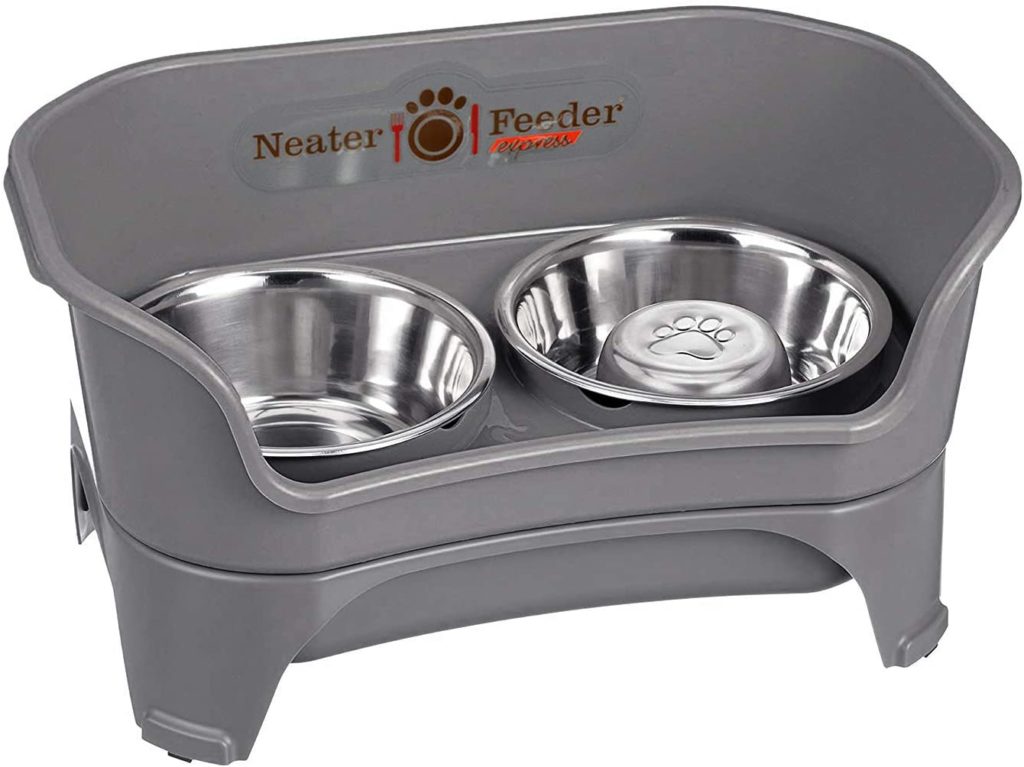
Great Dane Body Condition
Many pet parents are unsure of how much to feed a Great Dane or their Great Dane puppy. The condition of your Great Dane is the best indicator of how much food you should (or should not) be feeding.
If your Great Dane or Great Dane puppy is at a healthy weight, you are likely feeding the appropriate amount. Adult Great Danes should be on large or giant breed adult or senior formula.
Use the food chart as your guide.
You can see roughly how much to feed your Great Dane by looking at the back of your bag of dog food. As above, a Great Dane puppy may need to eat more than an adult Great Dane.
If your dog is overweight or obese, you will need to reduce your dog’s food intake and make sure they don’t get too many calories from their food, wet food, treats, or toppers.
If your dog is underweight, you may need to add more food and closely monitor food intake.
| Age | Timing | Amount |
| Puppies under 12 weeks | 3x/day | 2-4 cups/day |
| Puppies 12-24 weeks old | 3x/day | 3-6 cups/day |
| Puppies 24 + weeks (6 months) or older | 2x/day | 5-10 cups/day |
| Puppies 12-18 months | 2x/day | 6-12 cups/day |
| Adults 18+ Months | 2x/day | 4-8 cups/day |
BONUS POST: Is my Great Dane too Skinny!?
Body Condition Scoring for Dogs
The easiest way to check your dog’s body condition is to use the Body Condition Score. This nine-point system is based on how easily you can feel your dog’s ribs and whether or not there is an obvious waist.
For the Great Dane breed, you want to see a defined waist, a tuck in the abdomen, and good muscle development. Great Dane dogs should be lean and fit, never heavy or slow.
In general, a female Great Dane will be smaller, and a male Great Dane will have more substance. ‘Euro’ is a marketing term and not actually a reason for a dog to be heavy, chunk or overweight.
Always monitor what your Great Dane eats and feed them a proper diet (click here for our recommendations!)
If you are unsure of your dog’s body condition, please consult your veterinarian.
What if my Great Dane is Picky?
If your Great Dane or Great Dane puppy is turning their nose up at food, always address medical reasons first.
Most ‘picky’ dogs have either had enough and don’t actually need more kibble, or they have trained you to offer them different foods (they know you’ll give in)!
Remember, any Great Dane feeding chart that you find is a loose guideline, not a hard recommendation. If you really feel that your Great Dane is not eating enough, you must first start with a veterinary visit to rule out health problems.
You can also try enticing toppers such as raw egg, bone broth, Dr. Harvey’s (rehydrated), or canned foods; however, tread cautiously!
Bribing your dog to eat is a rabbit hole that you may not want to go down. Dogs will work for their food (training) and will not let themselves starve.
Our Top Picks for Great Dane Foods
- Purina Pro Plan Sensitive Skin and Stomach Large Breed (Salmon based, chicken free)
- Purina Pro Plan Large Breed Shredded Chicken & Rice (Large Pieces & Chicken Shreds!)
- Purina Pro Plan Large Breed Weight Management (Get the weight off)
- Purina Pro Plan Large Breed Bright Mind Age 7+ (for Senior Great Danes)
- Purina Pro Plan Giant Breed (Hard to find, might be discontinued)
- Royal Canin Giant Breed (Amazing for dogs with chronic loose stools, TOP TIER)
- Eukanuba Large Breed (Great for active and sport dogs)
- Purina One Smart Blend Large Breed (Fantastic budget-friendly option)
- Hill’s Science Diet Large Breed Beef & Rice
- Purina Pro Plan 30/20 Sport Beef & Bison
Cost of Feeding Great Dane Puppies
Giant breed puppies have big appetites and can eat up to 12 cups of food per day!
The cost of feeding a giant breed puppy will depend on the quality of food you choose and the size of your puppy.
On average, you can expect to spend $50-$100 per month on food for your giant breed puppy.
We also recommend supplements that can benefit the joints, increase gut health and reduce bloat risk.
Our favorite supplements for Great Dane owners to consider include:
Great Dane Feeding Chart
We recommend using this Great Dane Feeding Chart as a guide:
Fast-growing 12-week old Great Dane pups may actually eat more than adult Great Danes!
Because they tend to grow larger, a male Great Dane may also need more food than a female Great Dane. Great Danes in general have more complex nutritional needs than other breeds!
When considering exactly how much to feed a Great Dane, we recommend starting with the feeding chart on the back of the bag.
FEEDING GUIDELINES FOR GREAT DANES
This chart assumes you are feeding a quality kibble. Every kibble is different and some have more nutrition per cup than others. Some puppies receive more exercise or have a higher metabolism than others, too.
Remember that adding a lot of treats or toppers will change these ratios! These feeding guidelines are based on Purina Pro Plan Sensitive Formulas. Other kibbles and fresh foods may be different, and raw feeding will be by weight, not volume.
| Age | Timing | Amount |
| Puppies under 12 weeks | 3x/day | 2-4 cups/day |
| Puppies 12-24 weeks old | 3x/day | 3-6 cups/day |
| Puppies 24 + weeks (6 months) or older | 2x/day | 5-10 cups/day |
| Puppies 12-18 months | 2x/day | 6-12 cups/day |
| Adults 18+ Months | 2x/day | 4-8 cups/day |
Great Danes age 18-24 months +: switch to an adult formula and closely monitor body condition, especially after spay/neuter. We’ve linked to an important blog post on this topic below.
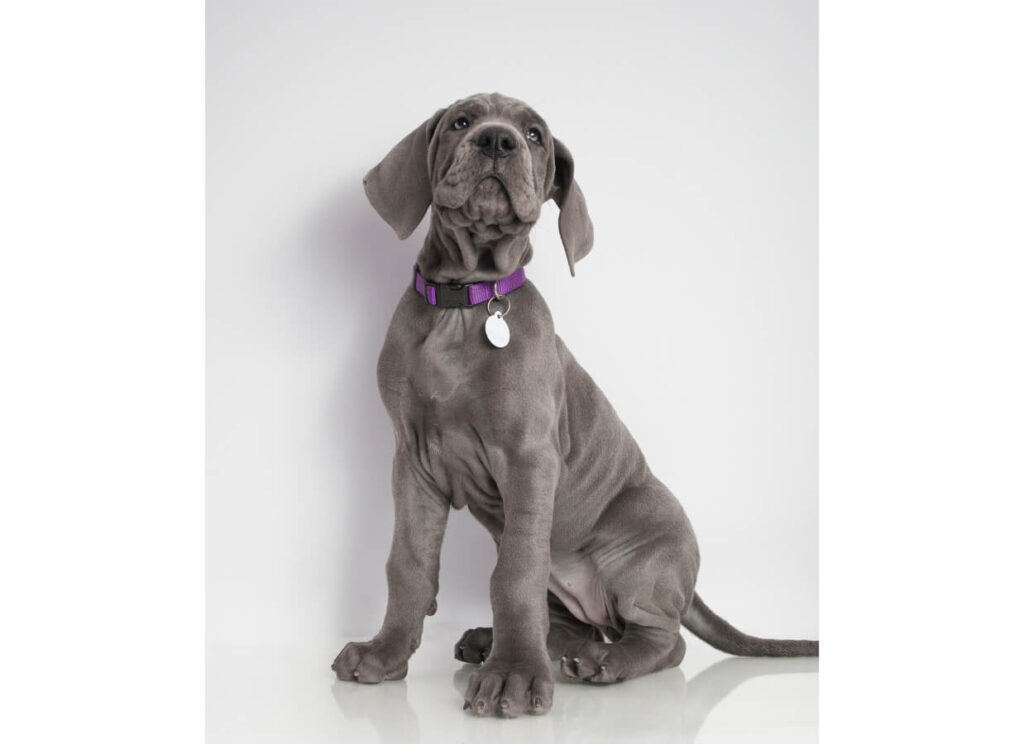
Does your Great Dane eat a lot? Leave a comment below! We’d love to know more about your Dane pup and the experience you’ve had with dog food.
We hope this Great Dane feeding chart has been helpful in determining how to best feed your pooch. As always, if you have any questions please consult your veterinarian.
Happy feeding!
READ MORE:



